Prices have been brought up to date, and are for stamps in 'average' condition. The currency is now selectable, the default is British Currency (£). I have revised Hiscocks' original listing, though leaving references to the original designations. The new designations have 'RH' numbers (Revised Hiscocks) to avoid confusion. Setup |
| Shortcuts to different sections: | |||||||||||
| Military Tel. | Unappropriated | Suakin Expedition 1885 |
COGH | 1884 codes | 1885 Provisional | 1886 Provisional | 1887 Overprints | Army Tel. | 1900 Prov. | Ashanti 1895-6. | Manœuvres 1896-9 |
| Boer War 1899-1902. | Unknown | Overprint flaw. | Forgeries. | Bisects. | Cancels. | Army Signals. | WWI. | WWII. | 1895 codes | Stationery. | References. |
Steve Hiscocks wrote:
Special telegraph stamps for military use were first ordered by Col. Webber for use by the British Army in Egypt. The 'Military Telegraphs' set was
received and presumably issued, in mid-September 1884. A further consignment was sent in late November 1884 to Capt. Jelf, commanding the
Telegraph Corps, for use in the Bechuanaland Expedition and yet more were sent in February 1885 for use in Suakin (Sudan). In March 1885 permanent
plates of the 'Military Telegraphs' overprint were made to replace the printer's type used up until then. The two versions are said to be identical
but with the later (plate) version a little 'clearer'. Being unaware of any sure means of distinguishing the two types I have not listed them separately.
In 1885 a temporary shortage of 6d & 1/- values led to the issue of hand written provisionals in Bechuanaland,
In 1886 the difficulty of equating the British currency of the stamps with the Egyptian currency in which charges were made led to the overprinting of all
stocks of Military Telegraph stamps in Egyptian currency. The dry climate had curled up the stamps such that they could not be overprinted in sheets
and in July 1886 the whole lot were done by hand with a self-inking revolving stamp. To avoid a repeat of that performance further supplies were
overprinted in a different format, before being sent out to Egypt in February 1887. The 'P.T.' of the local overprints stands for Turkish Piastre(s) of which
there were about 97.5 to the £1.
In 1895 the "Military Telegraphs" were replaced by "Army Telegraphs". These (except the ½d, 3d, 8d and £5) were used in Ashantee (Gold Coast)
in 1895 and (plus the ½d vermilion, 3d and 8d) on manoeuvres in England in 1896. The £5 was introduced in South Africa in 1899 and the ½d (green)
and two provisionals also in South Africa, in 1900—1901.
I have included under Great Britain the two "Military Telegraphs" overprints on Cape of Good Hope postage stamps since these were produced for
British Military use in Bechuanaland just after Sir Charles Warren entered Vryburg on 7 February 1885 and were not for public use. Logically I should
also include those of Orange River Colony overprinted "AT" but it seems less confusing to have them with the rest of the OFS and ORC.
Apart from the two Cape of Good Hope provisionals and the three halfpenny postage stamp provisionals, all military telegraph stamps were produced by
the addition of suitable wording, "MILITARY TELEGRAPHS" or "ARMY TELEGRAPHS", to the ordinary British 'unappropriated die' stamps which
were used for all manner of fiscal purposes at that time. These 'blank' stamps were available for many different values with empty tablets for the
insertion of words denoting the purpose for which they would be used. Penny, shilling and pound values were of different basic types, sizes and
colours and within those basic types each value was different in detail of ornamentation from all the others although superficially very similar.
Only one representative of each basic type has been illustrated below.
Military telegraph stamps used in Bechuanaland were cancelled with the same type of FIELD TELEGRAPH double ring cancellation as was used in
the Sudan. Ring diameters are 31 and 22mm (approx). Both the code letters above the date in the centre and the No. between the rings at the base differ
from station to station. Those known include: TS (Field Telegraph No. 44)-Taungs, VR (F.T. No. 32) and VR (F.T. No. 71)-Vryburg, GL-Barkly West
(Cape Colony), ML-Muller's Store (Cape Colony?), GU-Gunning's Store (Cape Colony?), BK-Bank's Drift, DH-Dry Hartz, BR-Brussels Farm, LP-
Leeuw Pan, GC-Groot Choing, SH-Sitlagoli, MZ-Maritzani, SA-Sanies, and MF-Mafeking. Field Telegraph Nos. are known only where given. The
above were reportedly in use in January-April 1885. Other offices were opened in June to July when the line was extended from Mafeking to
Molepolole but the code letters and numbers are not known.
My notes:
Hiscocks included the Cape of Good Hope stamps under Britain, but for consistency, I have moved these to Army Telegraphs 2 page
where I list other stamps used by the British Army that were not valid for use in the British Isles.
The Langmead & Huggins book covers the use of these quite well and mentions that two Cape of Good Hope stamps and a series
of Sudan stamps(page 110) were also used by the British Army Telegraphs units.
A Major A. B. Bagnold appears to have been involved in the production of these stamps and subsequent overprints.
His initials "aBB" are known on what presumably were specimens.
| There is a book 'TELEGRAPH and TELEPHONE Stamps of the World, a Priced and Annotated Catalogue' by S.E.R Hiscocks (1982) that I have used for information and catalogue designations, copies are in short supply. He catalogues stamps intended for telegraph and telephone use without regard of the cancel used. I on the other hand, want to identify items used with British Army cancellations (though sometimes this may have been postally). Where I am reasonably certain that a stamp exists with Army Telegraph cancellations but cannot illustrate one, I will illustrate with a mint or otherwise cancelled copy, giving Hiscocks designations. |
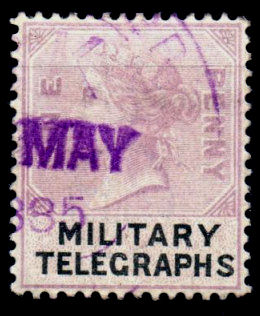 |
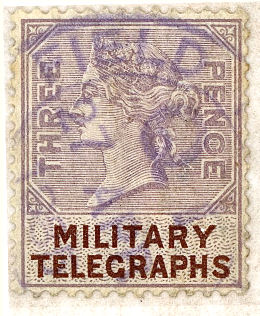 |
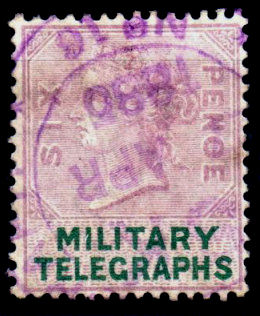 |
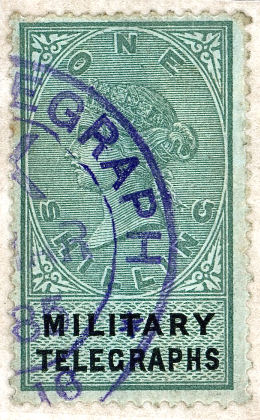 |
| GB-H1 (Suakin) | GB-H2 (Quarantine Island) courtesy of Mark Gibson |
GB-H3 (Suakin) | GB-H4 (Suakin) courtesy of Mark Gibson |
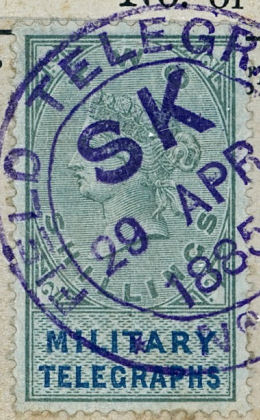 |
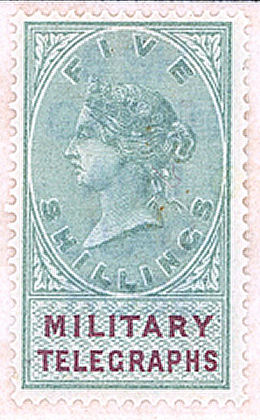 |
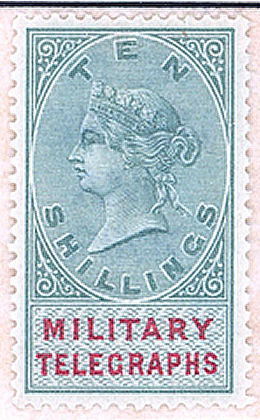 |
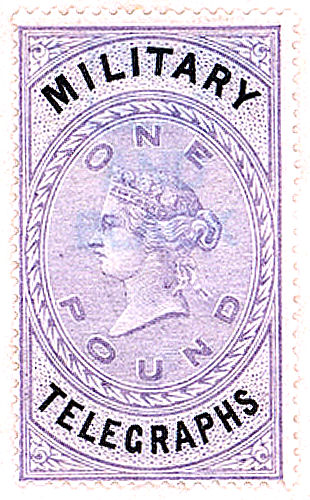 |
| GB-H5 (Suakin) | GB-H6 | GB-H7 | GB-H8 |
| Images courtesy of Mark Gibson. | |||
Perf.14
| RH # | Hisc. | Description | Rarity | Mint | Used | Specimen |
|---|---|---|---|---|---|---|
| RH1 | H1 | 1d reddish lilac and black, Wmk Orb | R1 | 40.00 | 55.00 | 35.00 |
| RH2 | H2 | 3d reddish lilac and brown, Wmk Orb | R1 | 40.00 | 55.00 | 35.00 |
| RH3 | H3 | 6d reddish lilac and green, Wmk Orb | R1 | 45.00 | 65.00 | 40.00 |
| RH4 | H4 | 1s dull green and black, Wmk Script VR | R1 | 45.00 | 60.00 | 40.00 |
| RH5 | H5 | 2s dull green and blue, Wmk Script VR | R1 | 65.00 | 75.00 | 55.00 |
| RH6 | H6 | 5s dull green and violet, Wmk Script VR | R1 | 70.00 | 100.00 | 60.00 |
| RH7 | H7 | 10s dull green and carmine, Wmk Script VR | R1 | 90.00 | 140.00 | 80.00 |
| RH8 | H8 | £1 reddish lilac and black, Wmk Orb | R2 | 180.00 | 270.00 | 160.00 |
Look here for an explanation of the table.
H9 and H10 are shown below under Cape of Good Hope.
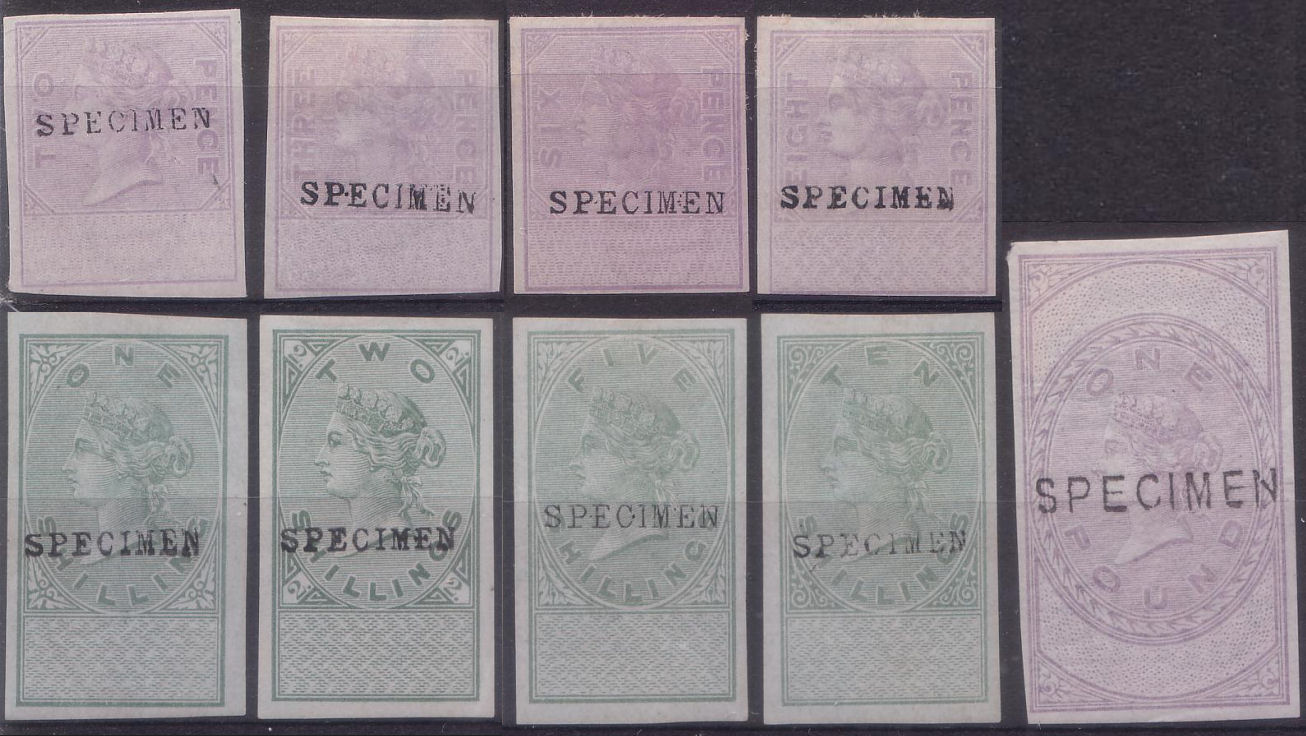
Examples of the Unappropriated stamps used to produce the Military and later Army Telegraph stamps - courtesy of Steve Lawrie.
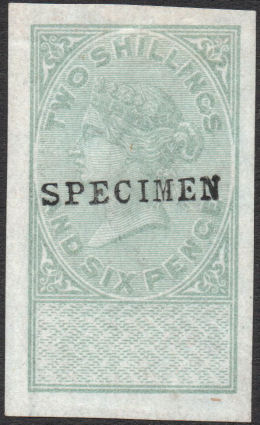 |
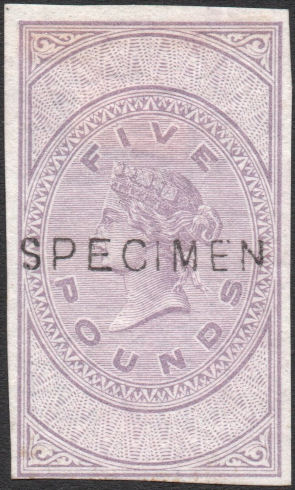 |
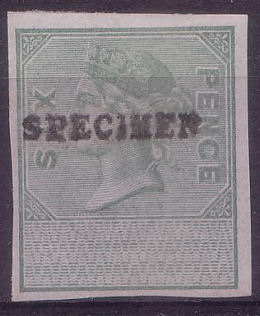 |
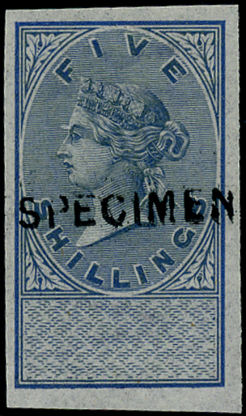 |
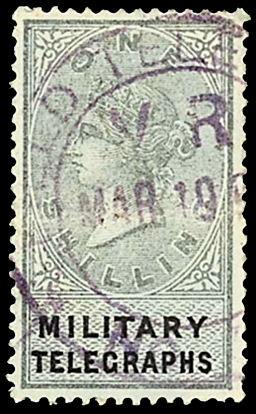 |
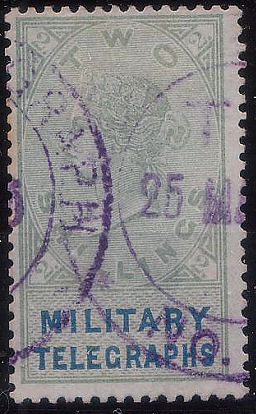 |
| Unappropriated stamps - remaining values | Unappropriated stamps could be produced in other colours for other uses. | GB-H4 (Vryburg) | GB-H5 (Taungs) | ||
| Courtesy of Steve Lawrie. | Courtesy of Mike-Holt.com | Courtesy of Spink and Son. | Courtesy of Steve Lawrie. | ||
As L & H noted (page 84) Telegraph stamps of India are known with special hand-stamps of "EGYPT EXPEDITION / 1885." in purple.
A range of these are shown on my page for India.
A selection of Military Telegraphs, mostly used in Suakin.
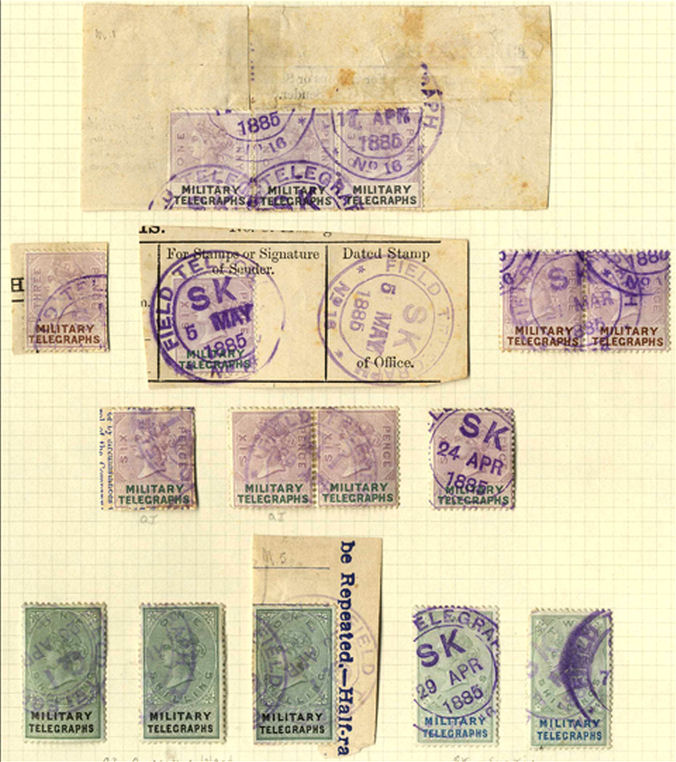
Courtesy of Spink and Son.
A selection of Military Telegraphs, used at Quarantine Island.
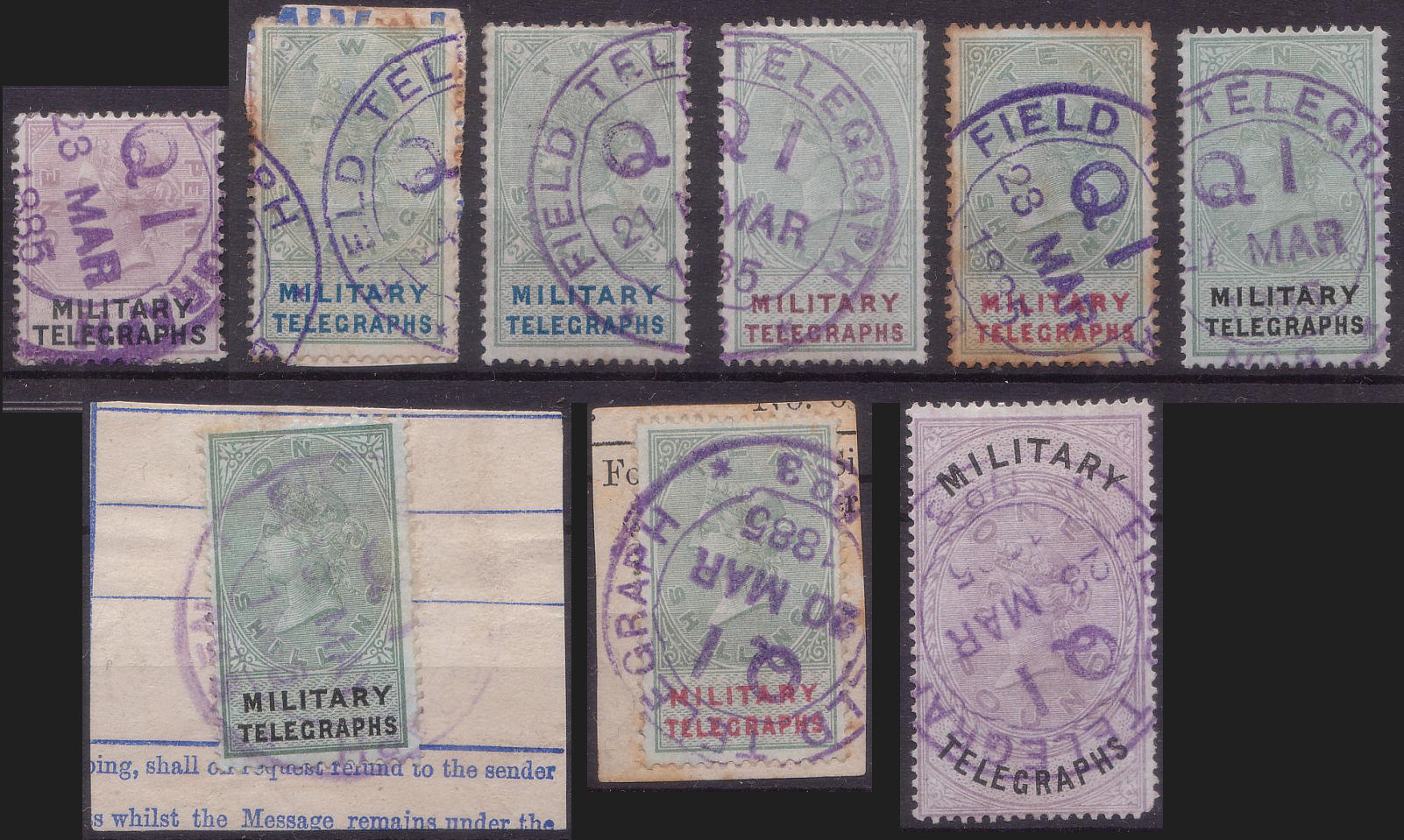
Courtesy of Steve Lawrie.
A Military Telegram from Mafeking to Setlagoli, Bechuanaland 14 July 1885, using an "Army Book, 295c." form printed by Harrison & Sons, London.
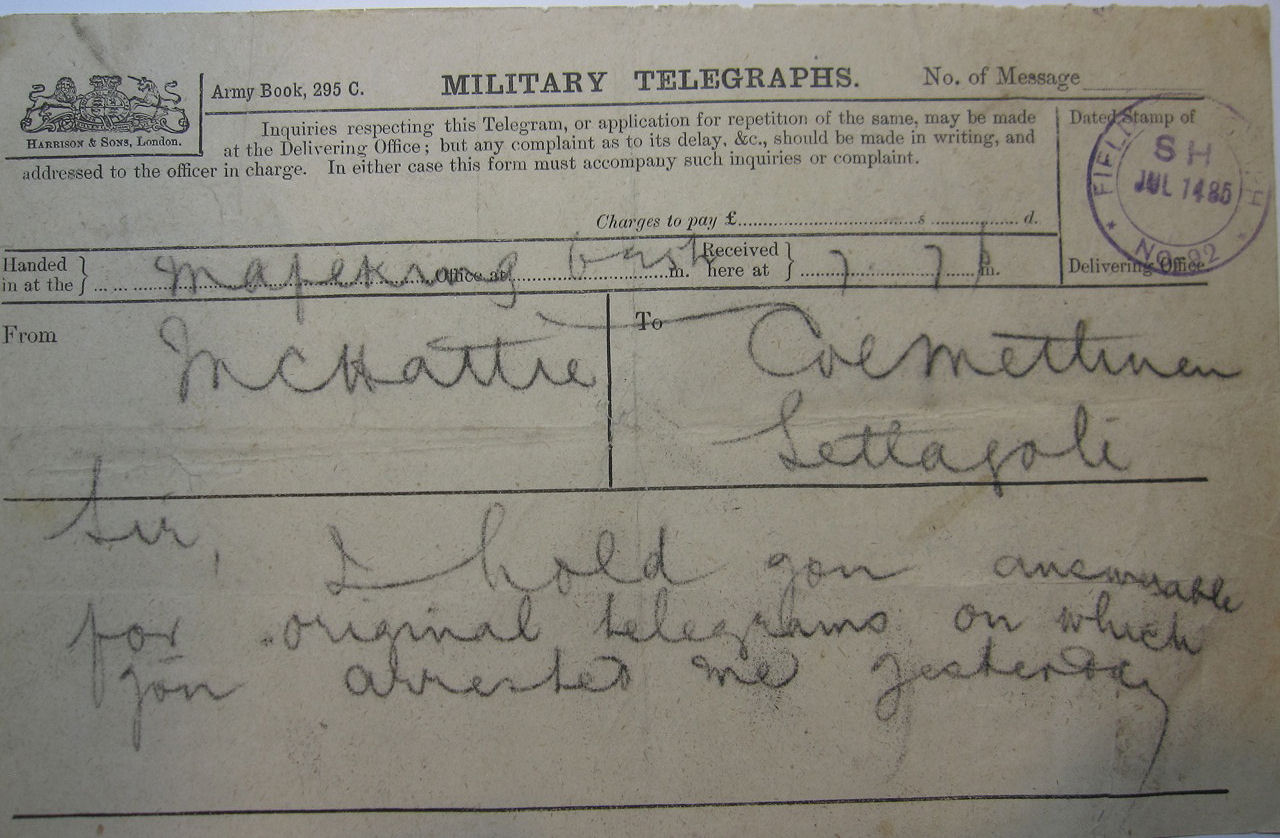
This has a datestamp with the code SH (No.92) for Setlagoli and is illustrated by L & H (Fig171, page 95) - Courtesy of Mark Gibson.
Same type form, but completed in Arabic, since it was used in Egypt.
Like Cairo, the cancel is in black, rather than the usual colour as on the form above.
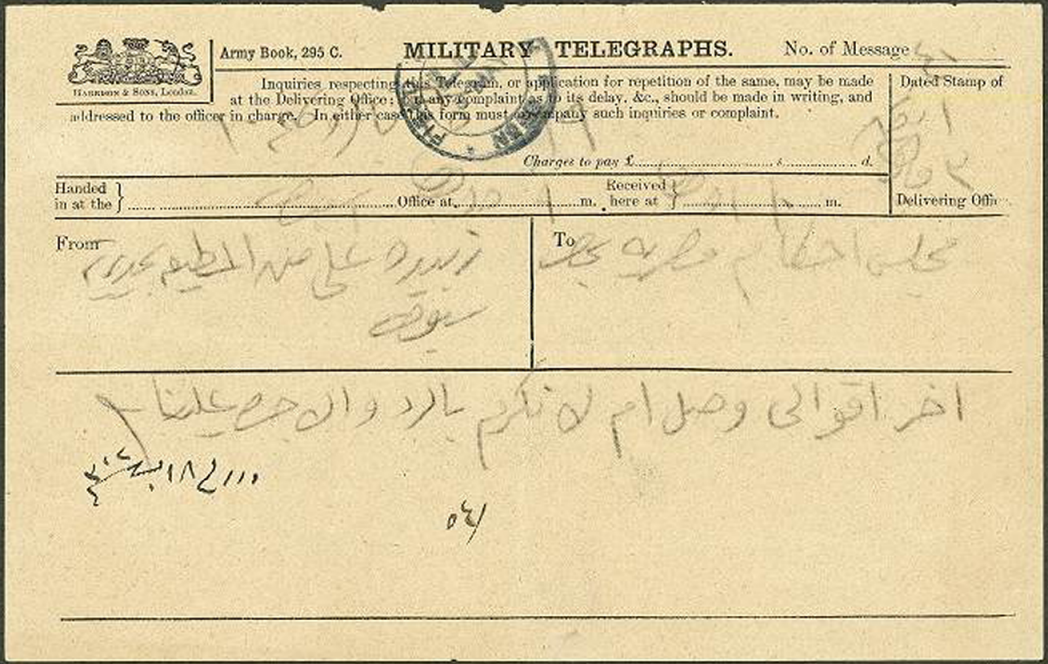
The date is said to be "9 MAY" with apparently no year. It is to the Council of Egyptian Decisions.
The code is LL which is thought to be Luxor Legal. - Image courtesy of Andrew Higson.
The cancellations used on this series was double-ring and generally included a two letter code for the office of use, and a number at the bottom.
Around the top was either 'ARMY TELEGRAPHS' or 'FIELD TELEGRAPH'. Codes known on these are :
As can be seen from the table above, quite a few stations have been reported/recorded, though most are rare.
The codes marked with L are listed by Langmead & Huggins on page 94, though it would be nice to verify them.
only about a quarter are common enough for me to be able to illustrate them currently.
The ones that are, are marked with a green tick. Click on a tick to see .
L & H (page 83) mention four 'principal offices' in Sudan: Suakin, Quarantine Island, Handub and the examples Headquarter Camp.
On the next page they say Handub and the Headquarter Camp are not recorded.
On page 81 they give an account of a known example of HL (see X on the table).
I would like to be able to illustrate examples of all of the known cancels.
If anyone can supply images that would help with that, I would be more than happy to give due credit.
As an exception, Cairo had 'CAIRO' inscribed between the
It is "ARMY TELEGRAPHS" rather than "FIELD TELEGRAPHS" and the months are in French.
rings around the bottom where the others had a number. Additionally it was in black instead of the usual purple.

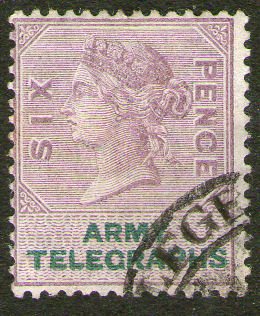

I first thought the Army Telegraph stamp in the middle, had a forged cancellation since it more resembled the earlier type on the left, but with serifs.
Then I saw the cancel on the Patent stamp on the right (courtesy of ibredguy.co.uk).
Now I think it may be a fiscal cancellation, "...LEGER" perhaps? Any ideas?
The Cairo cancel came from this presentation sheet.
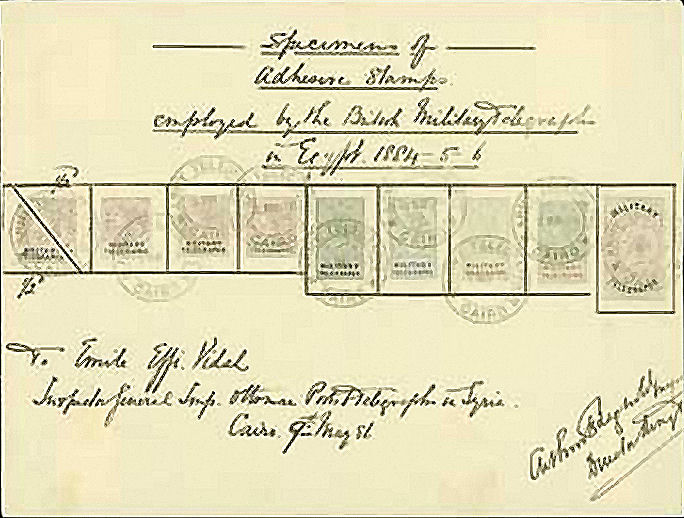
This is the only recorded usage of the bisected 1d value. Courtesy of Spink and Son.
However, it turns out that Cairo was not unique in using that type of Cancel.
Asswan did something similar, though in the usual purple, at least from December 1885 to January 1886.
The months are also in French.
Nearly the set ! - Courtesy of Mark Gibson.
"aBB" on (presumably) specimens Courtesy of Steve Lawrie.
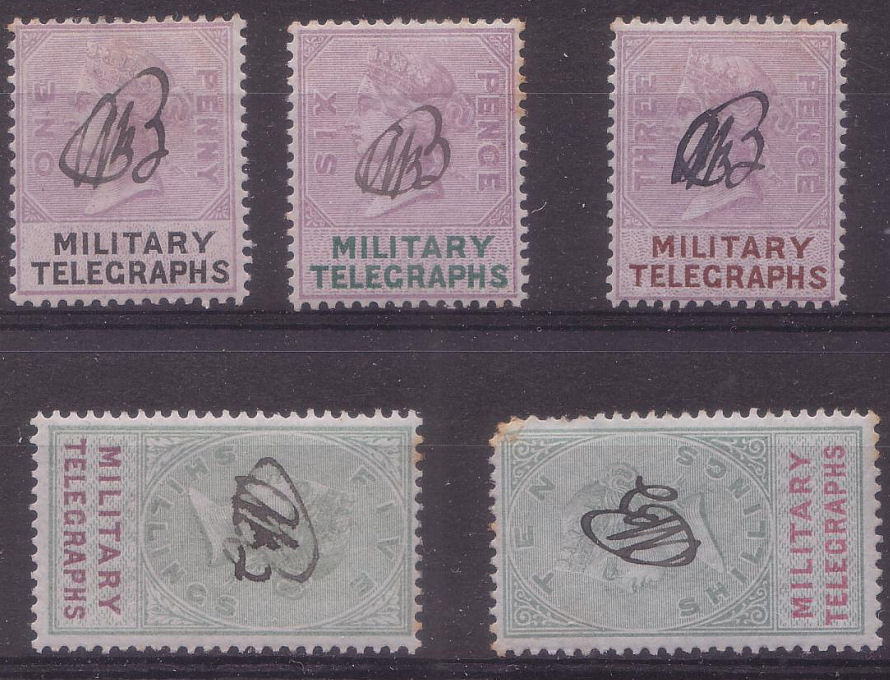
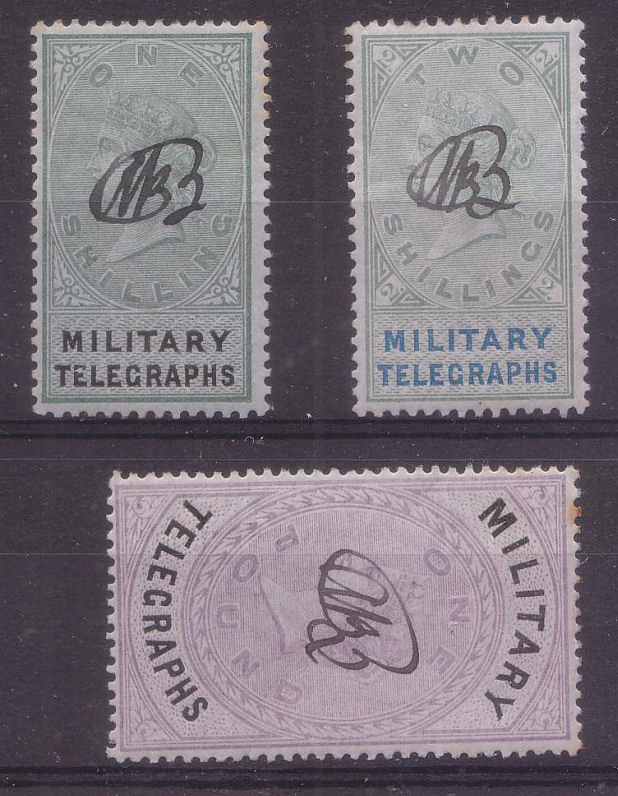
The initials are those of Major A. B. Bagnold.
The earliest known date for Telegraph stamps used on the Suakin Expedition is now 19 March 1885.
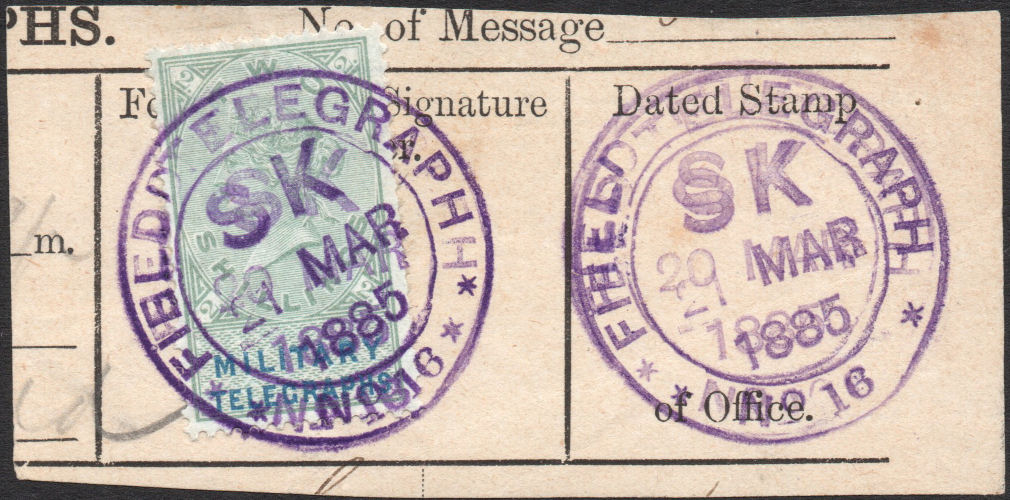
Suakin (No.16) Field Telegraph cancel with interesting dates, must have been the first of the next day - Courtesy of Steve Lawrie.
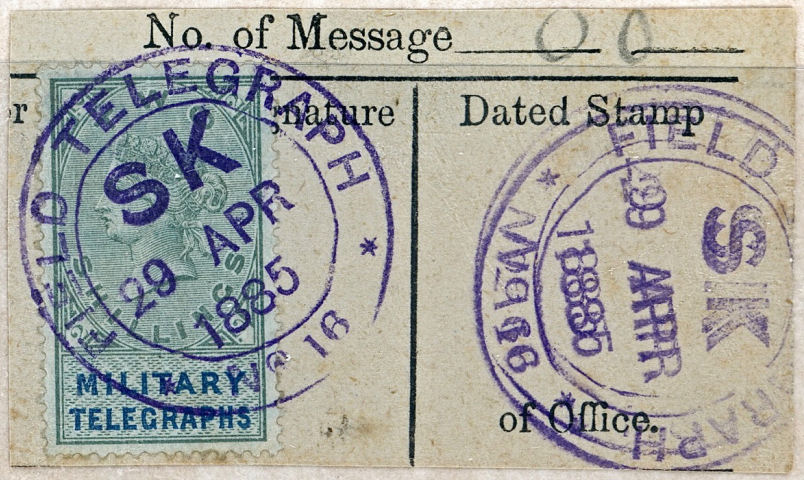
Suakin (No.16) Field Telegraph cancel on 2s courtesy of Mark Gibson.
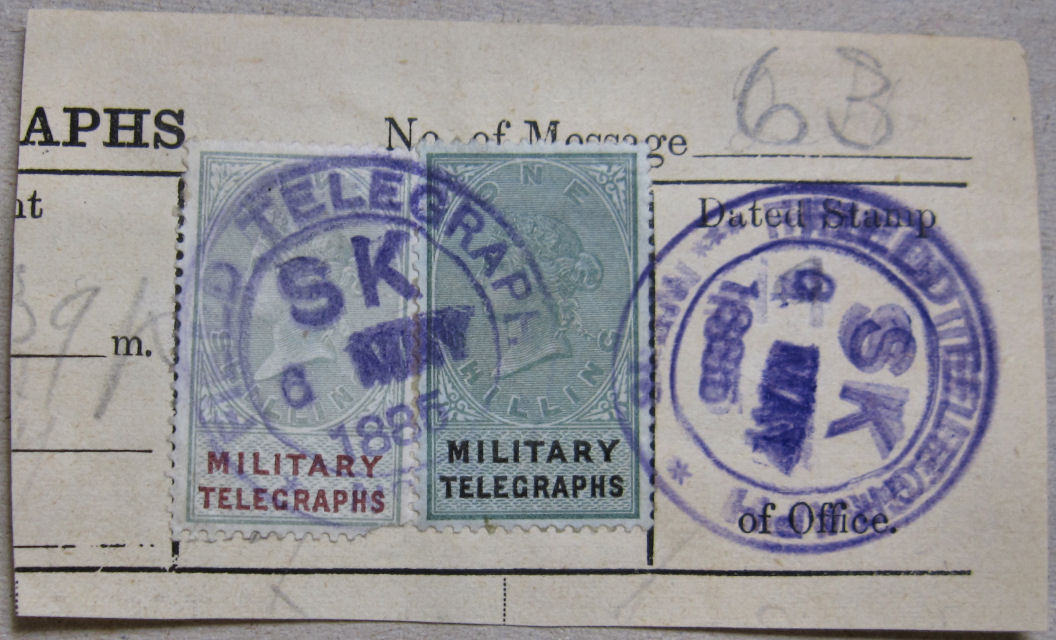
Suakin (No.16) Field Telegraph cancel on 1s and 5s courtesy of Mark Gibson.
This is dated May 6th 1885. They are known up until the 15th.
These get a brief mention on page 95 of L & H along with illustrations of H13, Hiscocks listed them all with equal values.
Illustrations are half-size and courtesy of Grosvenor Auctions and Spink & Son.
Hiscocks adds the following note:
| Note. These were to meet a temporary shortage of 6d and 1s values. It is not known how many were altered but they are rare. Mint copies of these stamps have not been reported and they were probably surcharged as required. Beware of forgeries! |
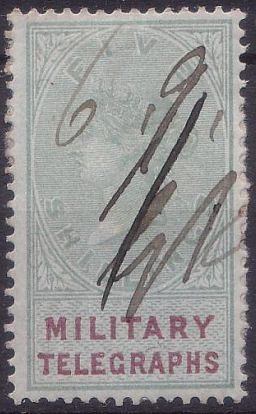 |
This is like the Spink & Son stamps above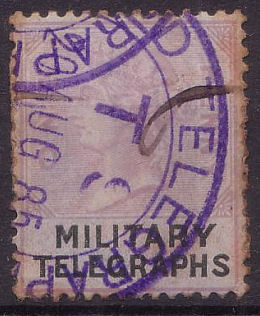 The one on the left is pen-cancelled and dated 6/9/85 (?) It has a 1981 RPSL Certificate (119403, submitted by Peter Langmead) which gives it the Yvert number of M11. |
| H13 and H11 images courtesy of Steve Lawrie. | |
Perf.14
The last three are specimens courtesy of Steve Lawrie.
| RH # | Hisc. | Description | Rarity | Mint | Used | Specimen |
|---|---|---|---|---|---|---|
| RH15 | H15 | 0.1 PT on 1d reddish lilac and black | R3 | 60.00 | 60.00 | - |
| RH15a | H15a | bisected on piece | R3 | - | 150.00 | - |
| RH16 | H16 | 0.25 PT on 3d reddish lilac and brown | R3 | 60.00 | 60.00 | - |
| RH16a | H16a | bisected on piece | R3 | - | 150.00 | - |
| RH17 | H17 | 1 PT on 6d reddish lilac and green | R3 | 75.00 | 75.00 | - |
| RH18 | H18 | 5 PT on 1s dull green and black | R3 | 90.00 | 90.00 | - |
| RH19 | H19 | 10 PT on 2s dull green and blue | R3 | 90.00 | 90.00 | - |
| RH20 | H20 | 25 PT on 5s dull green and violet | R3 | 120.00 | 120.00 | - |
| RH21 | H21 | 50 PT on 10s dull green and carmine | R3 | 150.00 | 150.00 | - |
| RH22 | H22 | 100 PT on £1 reddish lilac and black | R3 | 225.00 | 225.00 | - |
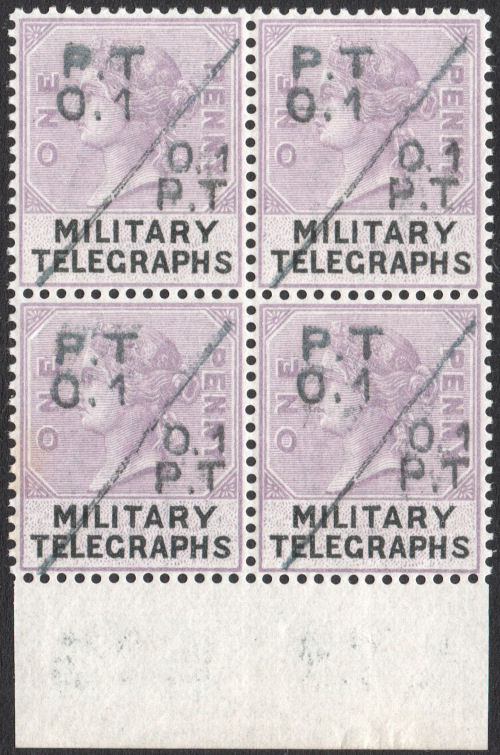
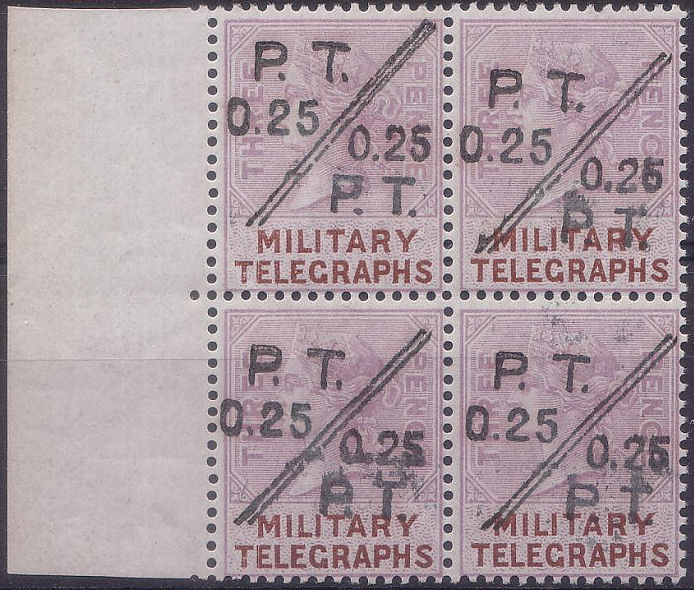
H 15 and H16 marginal blocks of four, courtesy of Steve Lawrie.
| Image courtesy of Grosvenor Auctions. | Images courtesy of Steve Lawrie. |
This is the Appendix B
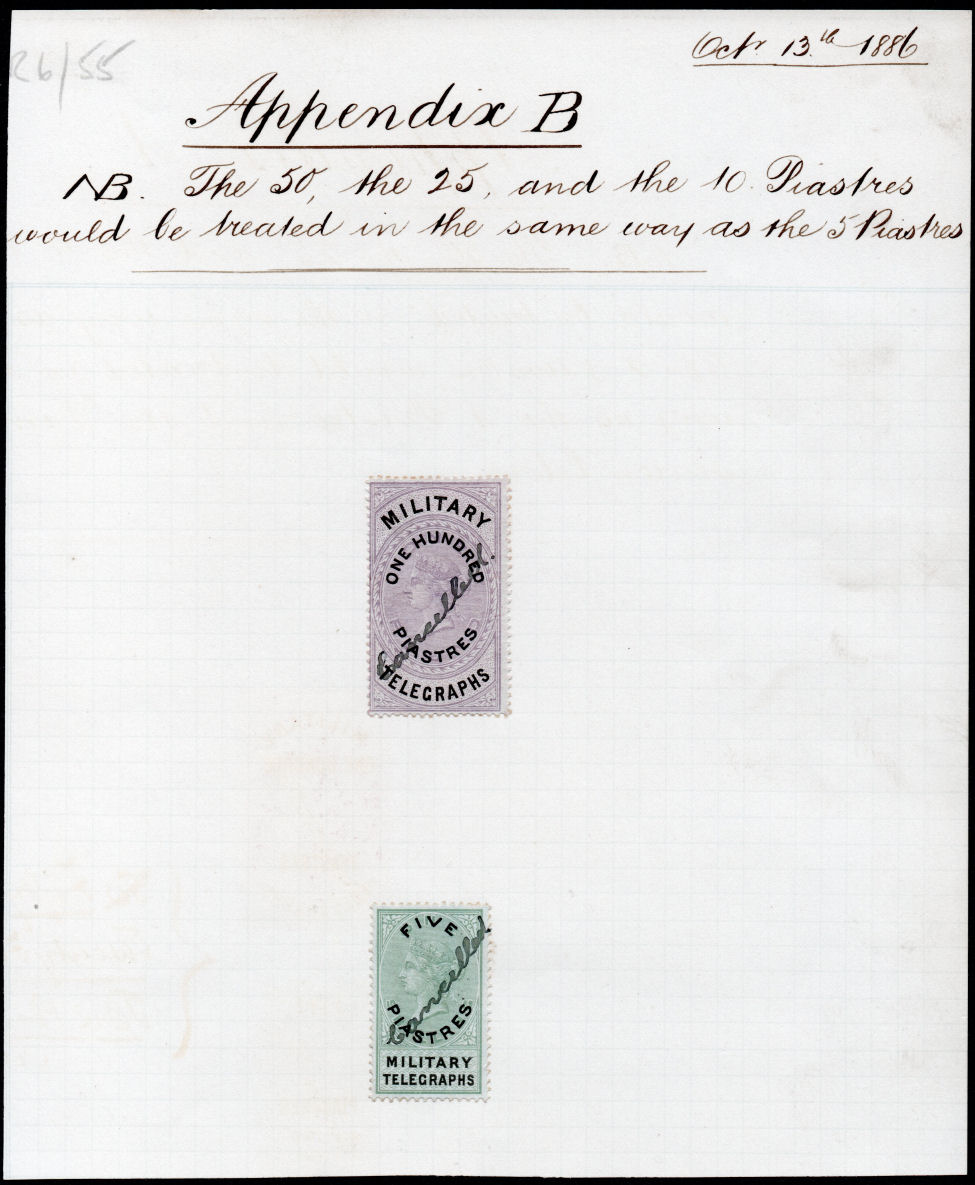
Major Bagnold additionally wanted 2 piastres on 8d and 2 dime on the 2d which were additional to the original Military Telegraph series.
This is where I hit a point of confusion. On 'Appendix A' above, Major Bagnold appears to have initialled his instructions with 'aBB Major'.
Langmead & Huggins refer to him as Major Arthur H. Bagnold ! So why the initials aBB ?
An internet search found an Arthur Henry Bagnold who was born 1854 and died as a Colonel in 1943, but nobody that appeared to match the initials.
The initials do however seem to match the monograms on the stamps below:
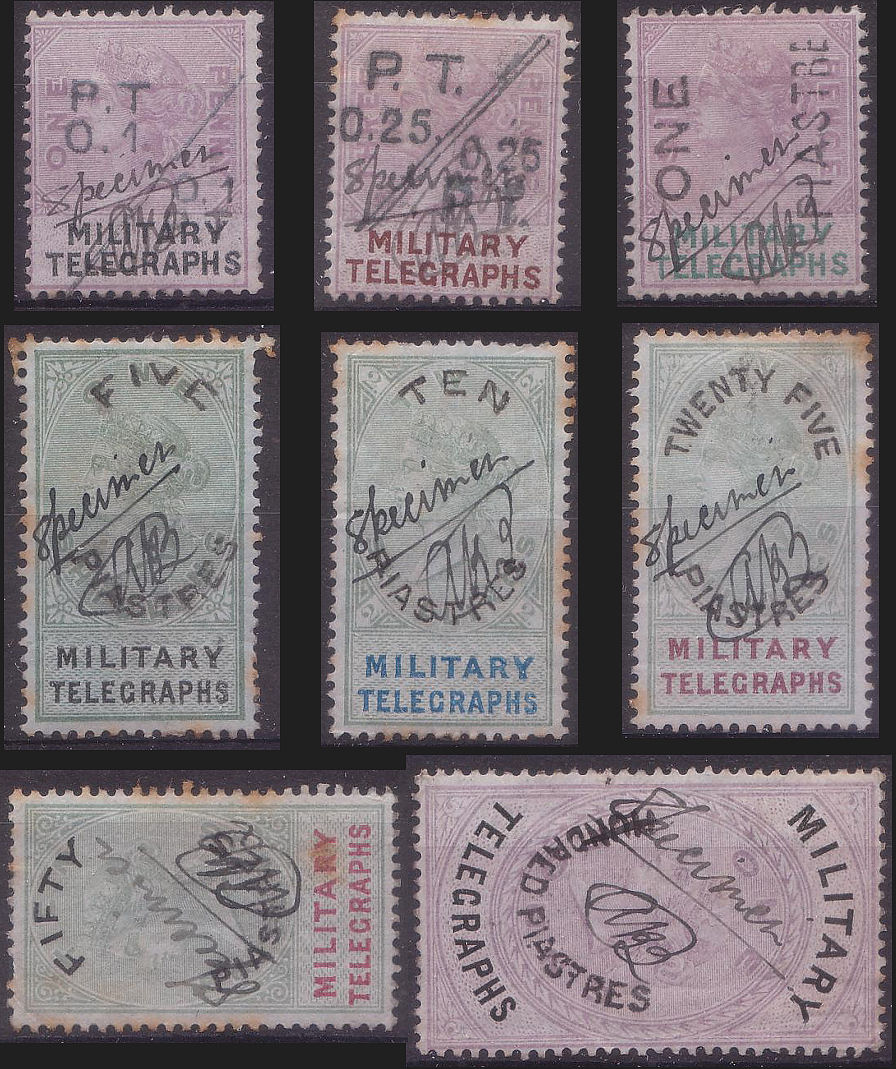
Images courtesy of Steve Lawrie.
Up to this point, all of, what might be regarded as Specimens of this issue, are done in manuscript.
There were printed specimens of the unoverprinted stamps, as well as the later "Army Telegraphs".
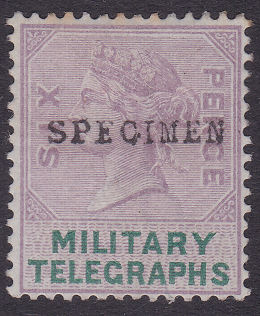
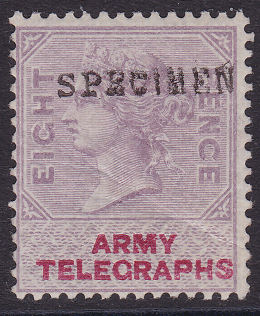
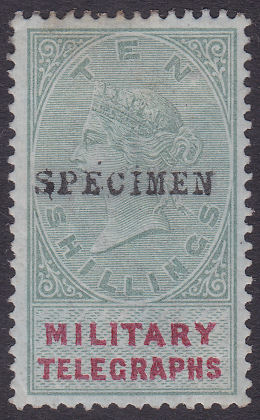
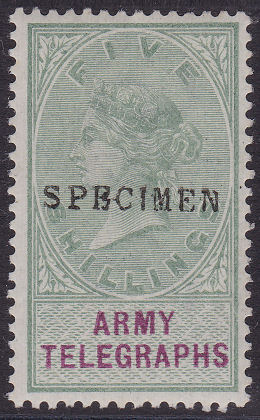
Some of my Military and Army specimens without overprints. They are very similar, all in black and none have a period at the end.
Derek Harborne has made me aware though that there are also some of the overprinted stamps with printed "SPECIMEN."
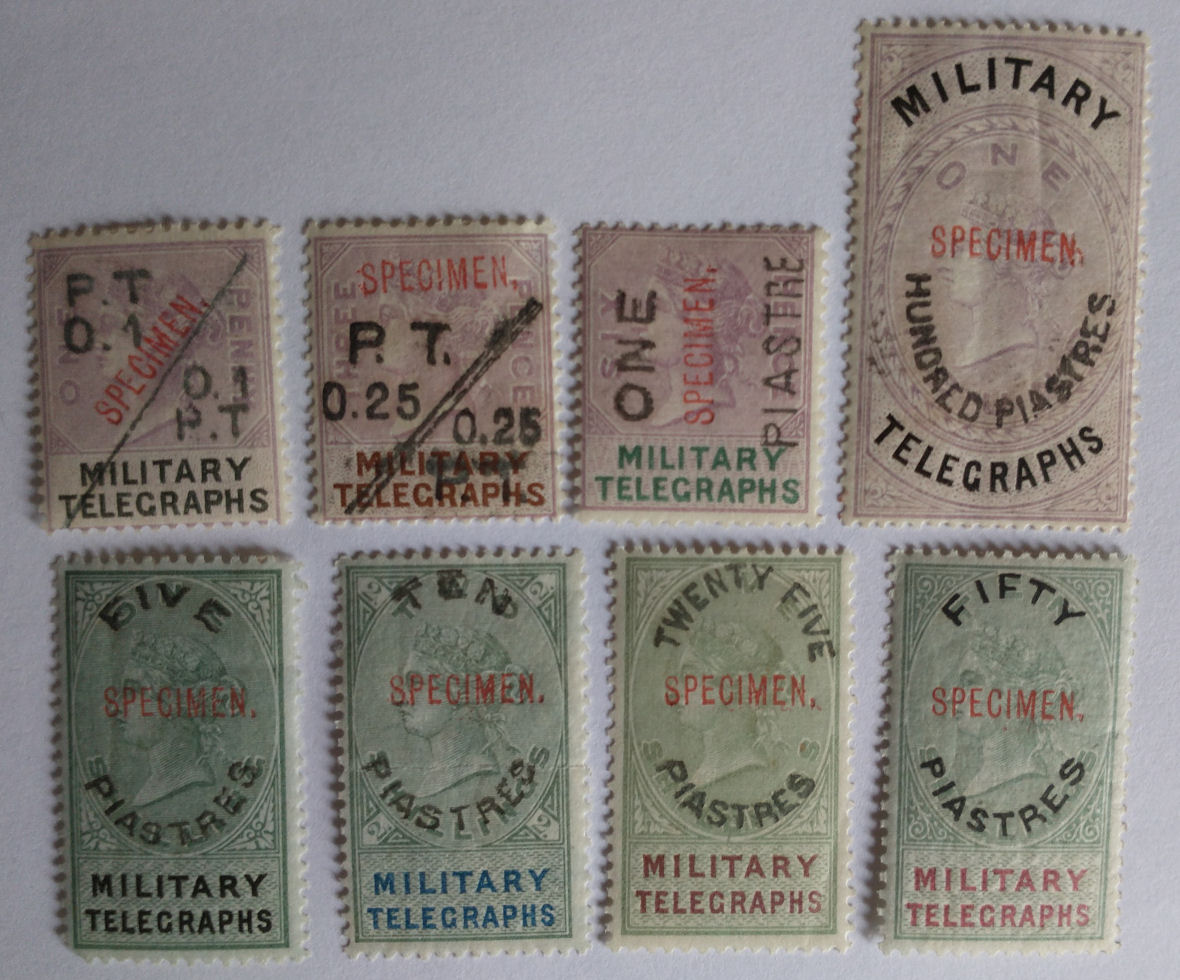
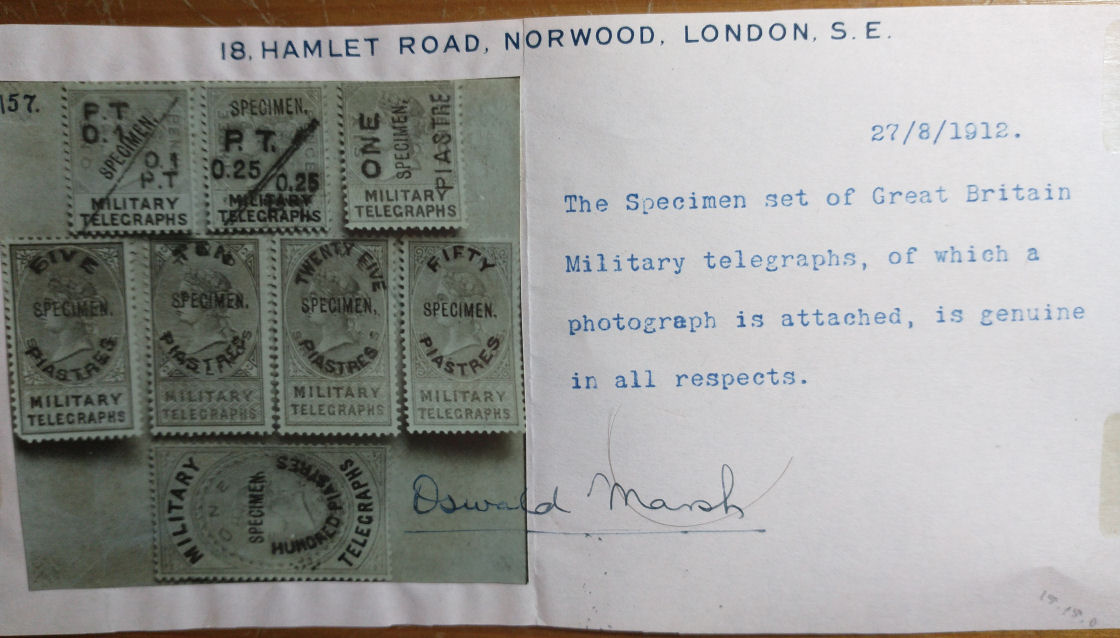
Unusually, the 'SPECIMEN.' is in red on all of them. They were expertised by Oswald Marsh in 1912 and subsequently purchased from Stanley Gibbons.
Images courtesy of Derek Harborne.
More information and illustrations of these can be found in
British Military Telegraphs in Egypt 1884-1890 by Dr Andrew Higson FRPSL.
| RH # | Hisc. | Perf.14 Description | Rarity | Mint | Used | Specimen |
|---|---|---|---|---|---|---|
| RH23 | H23 | 1 dime on 1d | R2 | 30.00 | 15.00 | 25.00 |
| RH24 | H24 | 2 dime on 2d | R2 | 30.00 | 15.00 | 25.00 |
| RH25 | H25 | 5 dime on 3d | R2 | 40.00 | 18.00 | 32.00 |
| RH26 | H26 | 1 piastre on 6d | R2 | 40.00 | 18.00 | 32.00 |
| RH27 | H27 | 2 piastre on 8d | R2 | 45.00 | 18.00 | 35.00 |
| RH28 | H28 | 5 piastre on 1s | R2 | 25.00 | 15.00 | 22.00 |
| RH29 | H29 | 10 piastre on 2s | R2 | 45.00 | 18.00 | 35.00 |
| RH30 | H30 | 25 piastre on 5s | R2 | 65.00 | 30.00 | 55.00 |
| RH31 | H31 | 50 piastre on 10s | R2 | 80.00 | 35.00 | 65.00 |
| RH32 | H32 | 100 piastre on £1 | R3 | 150.00 | 75.00 | 125.00 |
Look here for an explanation of the table.
Comment: the Rarity Guide of Langmead & Huggins would suggest that the first Military series and the first Army series
are of about equal rarity, but my experience tells me that the Army Series is much more common as I have
nearly 2 sets now mint plus several used compared to only two plus a specimen of the Military issues!
Specimens exist showing alternative proposals for these.
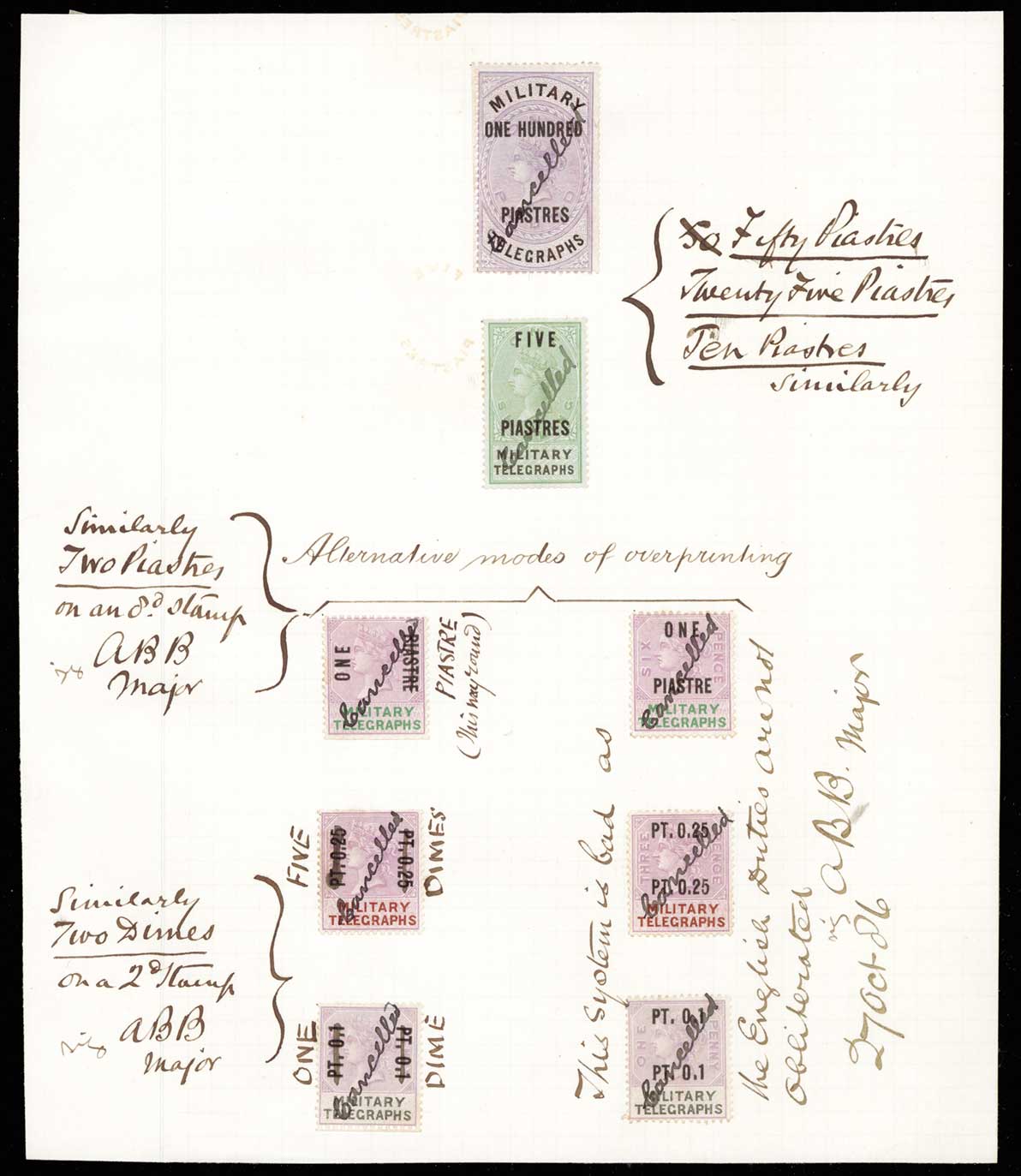
Image courtesy of Grosvenor Auctions. The image shown by L & H (Fig. 163) has "Appendix A Oct 13th 1886" at the top. This has been cut off or folded under.
Note the references to "aBB Major". There are examples with those initials, presumably specimens.
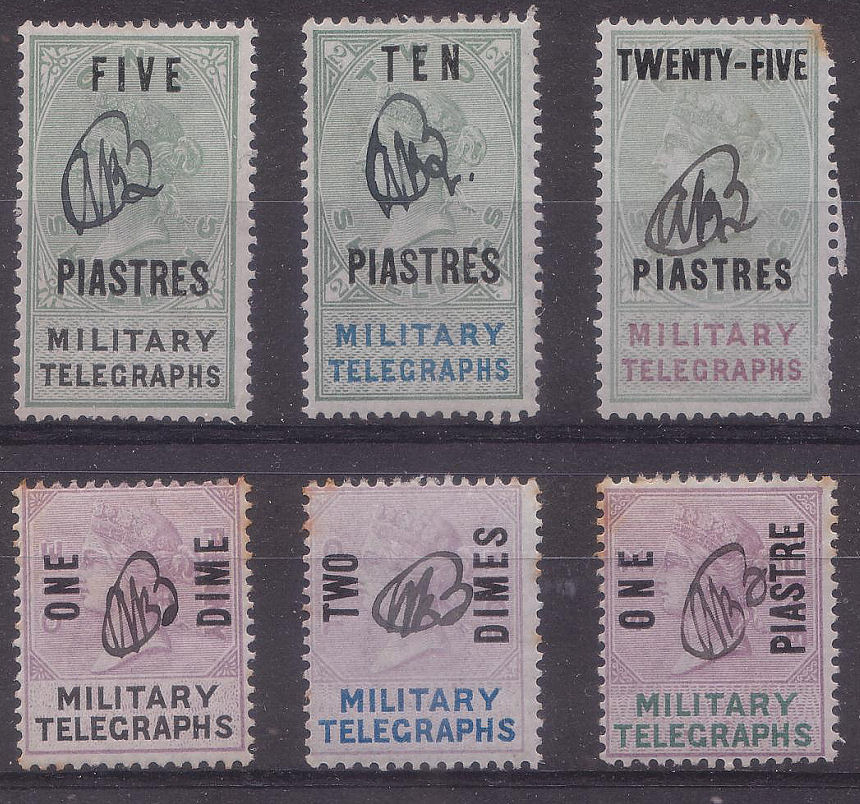
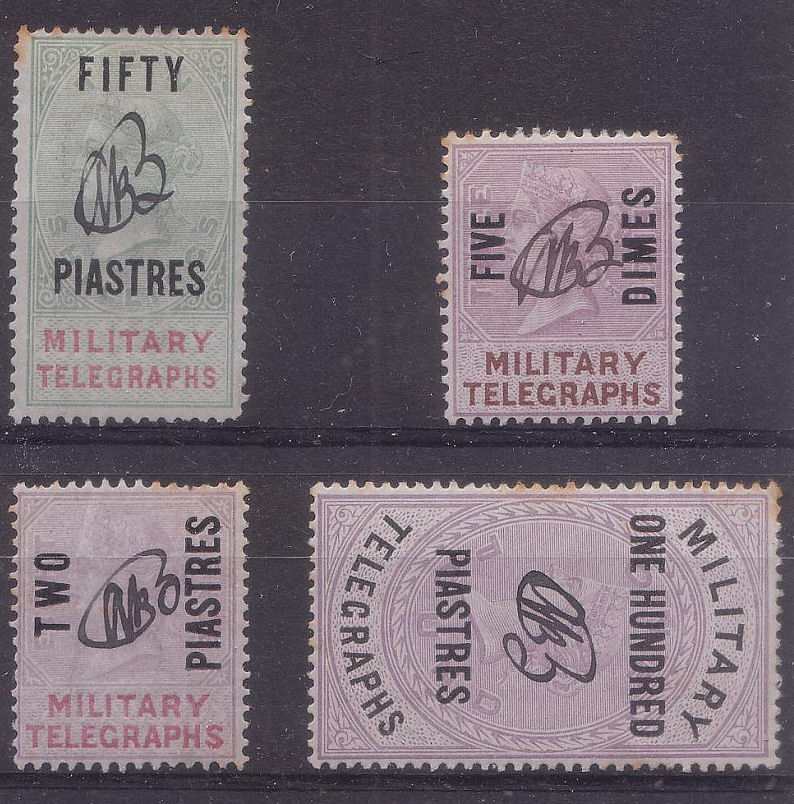
Images courtesy of Steve Lawrie.
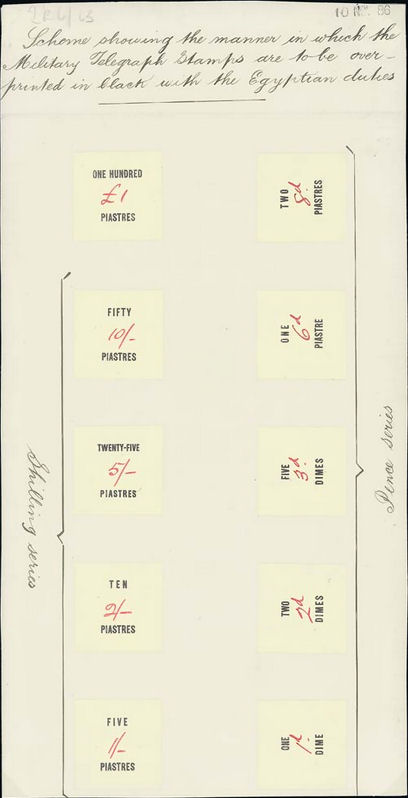 |
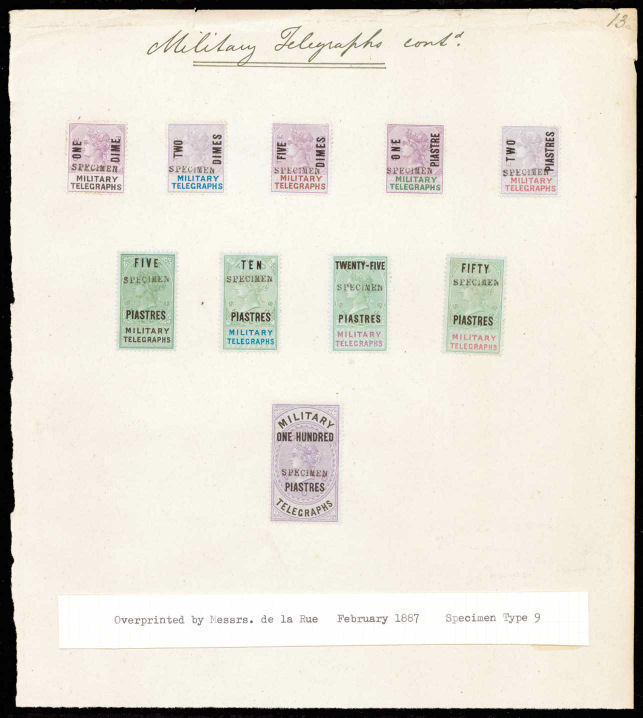 Click on the image for a larger version. More can be seen at the GB Overprints Society |
| Dated 10 November 1886, courtesy of Spink and Son. | Courtesy of Grosvenor Auctions. |
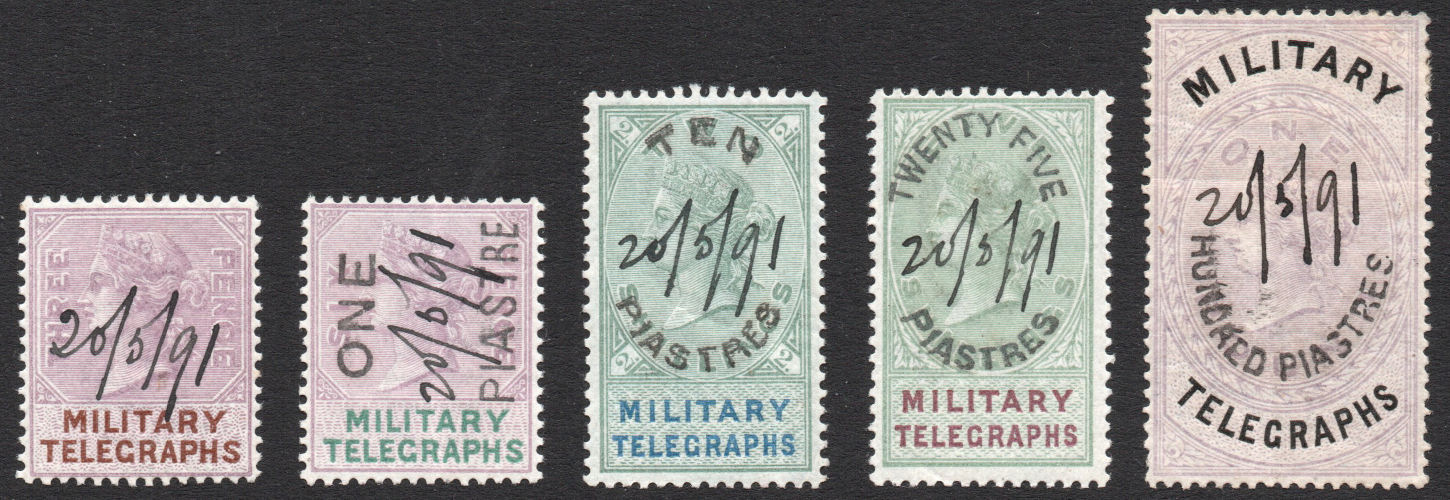
Examples of the 1886 overprint (plus an un-overprinted 3d), all with manuscript "20/5/91".
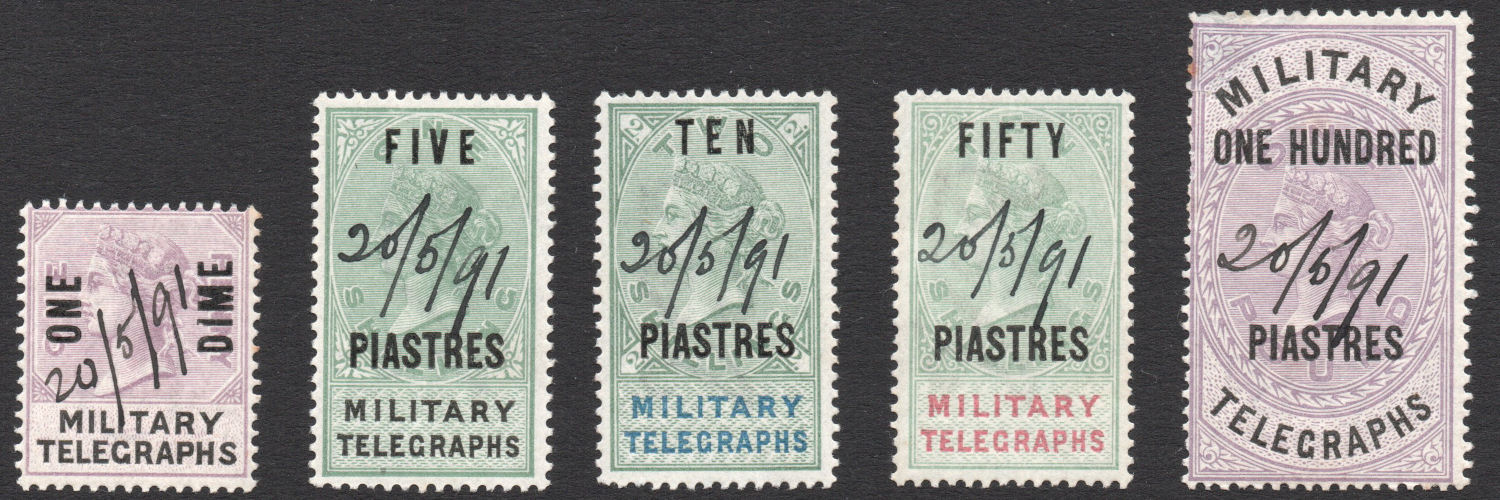
Examples of the 1887 overprint, again all with manuscript "20/5/91". I do not know why these were created, or the significance of the date, but would welcome suggestions.
Images courtesy of Steve Lawrie.
Since I am interested in all stamps used for British Telegraphic purposes as well as just the ones intended for such use, I am concentrating here on the used ones
because the used ones can identify telegraphic usage of normal postage stamps (more relevant below).
Be aware that the purple and green inks used to print these stamps were fugitive inks designed to change colour with soaking to prevent re-use of stamps after cleaning.
Avoid getting them wet.
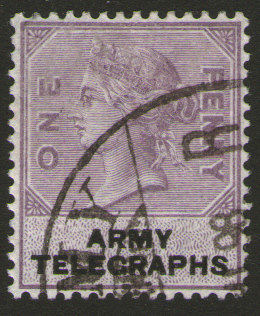 |
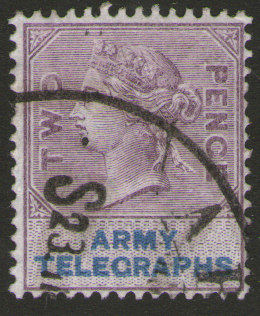 |
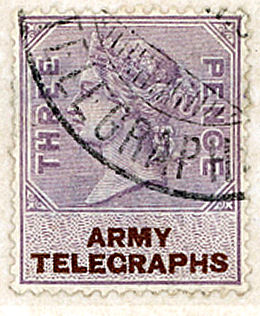 |
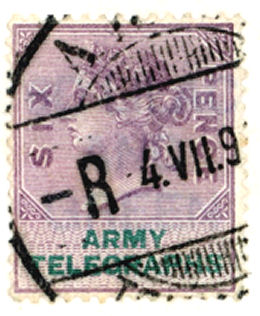 |
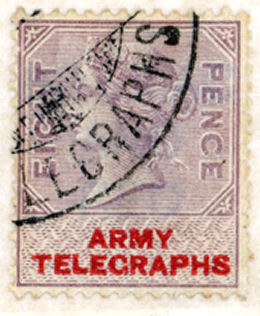 |
| 1d GB-H36 | 2d GB-H37 (known bisected) | 3d GB-H38 | 6d GB-H39 (known bisected) courtesy of Mark Gibson |
8d GB-H40 courtesy of Mark Gibson |
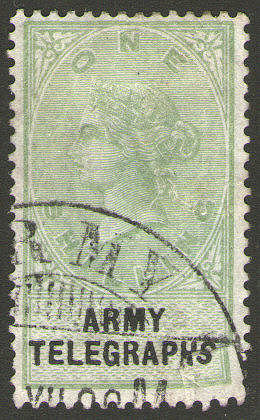 |
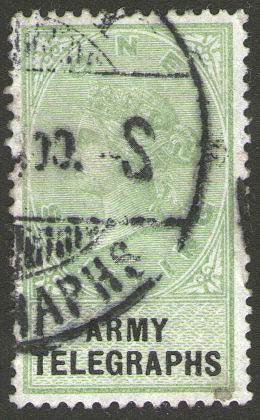 |
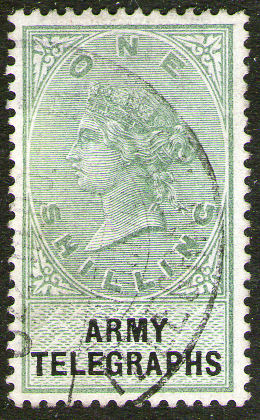 |
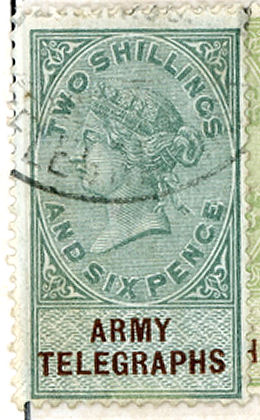 |
| 1s GB-H41 (known bisected) | 1s GB-H41 (known bisected) | 1s GB-H41 feint -S 22.III.00 -R Elandslaagte, Natal |
2s6d GB-H42 courtesy of Mark Gibson |
Note the yellowing of the 1s stamps. It was common practice in GB at the time to use fugitive ink for green stamps to make it harder to re-use them
Soaking for too long washes away the blue components of the ink (don't do it).
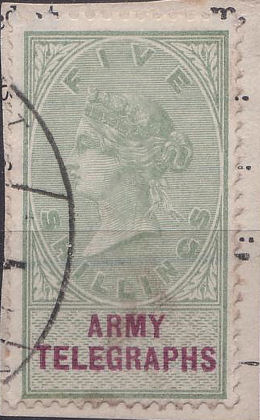 |
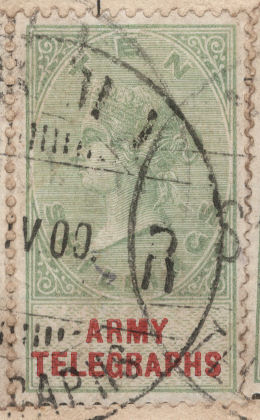 |
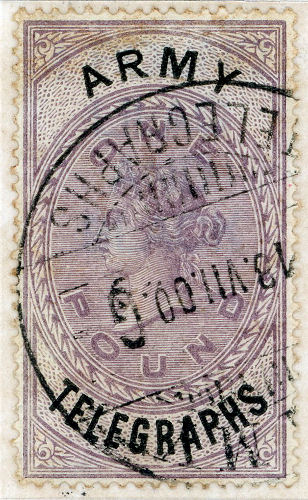 |
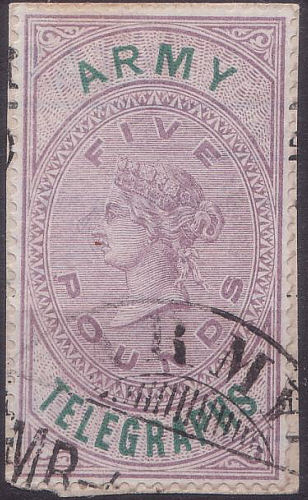 |
| 5s GB-H43 - courtesy of Steve Lawrie. | 10s GB-H44 - courtesy of Mark Gibson. | £1 GB-H45 - courtesy of Mark Gibson. | £5 GB-H46 - courtesy of Steve Lawrie. |
H37, H39 and H41 are known bisected (Stanley Gibbons sale Autumn 2005 lots 512-516). I will add those as RH37a, RH39a and RH41a respectively.
See also the article by Jim Buckingham in The Anglo-Boer War Philatelist 2005, pages 88 and 89.
Some more illustrations and information about these can be seen at Tripod.
Also page 67 of GBPS Journal
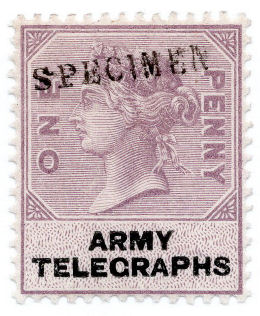 |
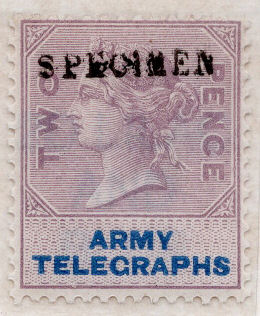 |
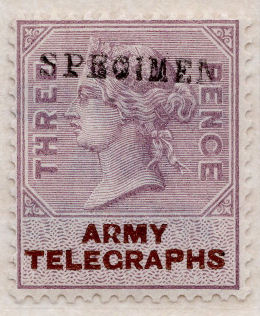 |
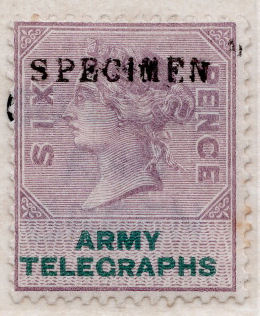 |
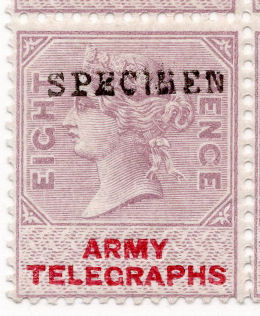 |
| Specimen (Type 9) series of 1d to 8d (RH36s to RH40s) courtesy of Mark Gibson. | ||||
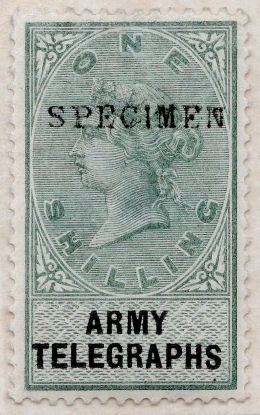 |
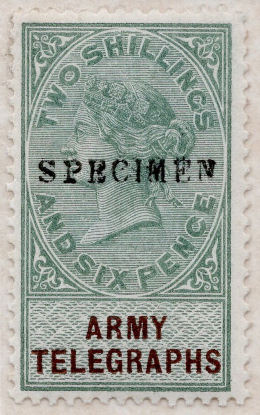 |
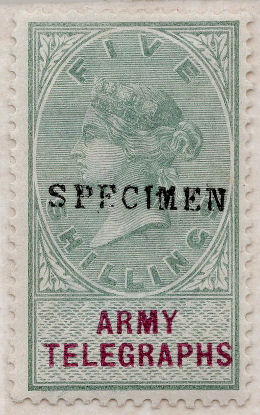 |
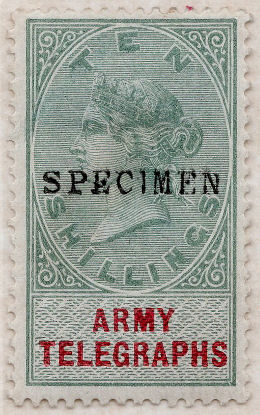 |
| Specimen (Type 9) series of 1s to 10s (RH41s to RH44s) courtesy of Mark Gibson. | |||
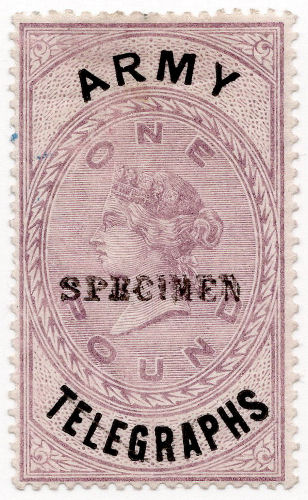 |
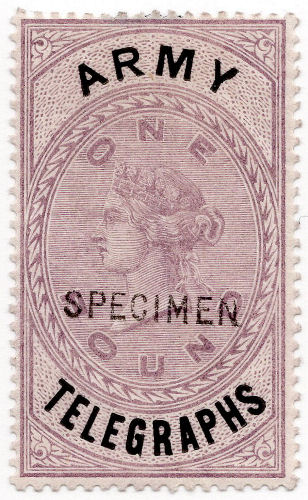 |
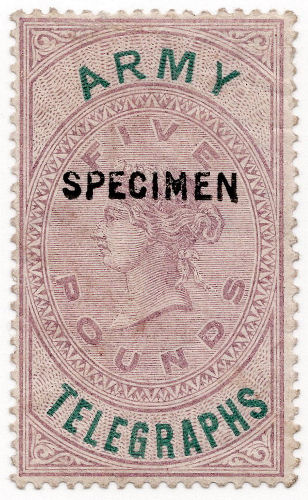 |
| £1 Specimen (Type 9) - RH45s-9. Courtesy of Mark Gibson. |
£1 Specimen (Type 15) - RH45s-15. Courtesy of Mark Gibson. |
£5 Specimen (Type 15) - RH46s-15. Courtesy of Mark Gibson. |
Perf.14
* These are not listed by Hiscocks
H37, H39 and H41 are known bisected from Stanley Gibbons sale Autumn 2005 lots 512-516).
See also the article by Jim Buckingham in The Anglo-Boer War Philatelist 2005, pages 88 and 89.
Examples of bisects are shown lower down on this page.
There was no unappropriated dies for the halfpenny, so in 1896 the existing halfpenny vermilion was overprinted with the same 7mm setting for 'ARMY' as was used for the other low values (1d to 8d) and is relatively common. Printing began 19 August 1896. Later (1900) the halfpenny in green was used, initially in the same 7mm setting but later (1901) in an 8mm setting with the letters of 'ARMY' being noticeably more spaced and thinner.
An easy way to see the difference is that the new type has a horizontal bar added to the 'G' in 'TELEGRAPHS'.
Langmead & Huggins show the first type in Fig.192 and the new types in Figs.194, 195 and 196 with a rather cryptic reference to a 'new overprint' without further explanation.
Their rarity guide does not distinguish between the two but I think the wide setting is scarcer, although Hiscocks pricing is twice as much for the first type. Many of the first type though appear to be forgeries (see below).
See GB Overprints Society for illustrations of these and scarcer items.
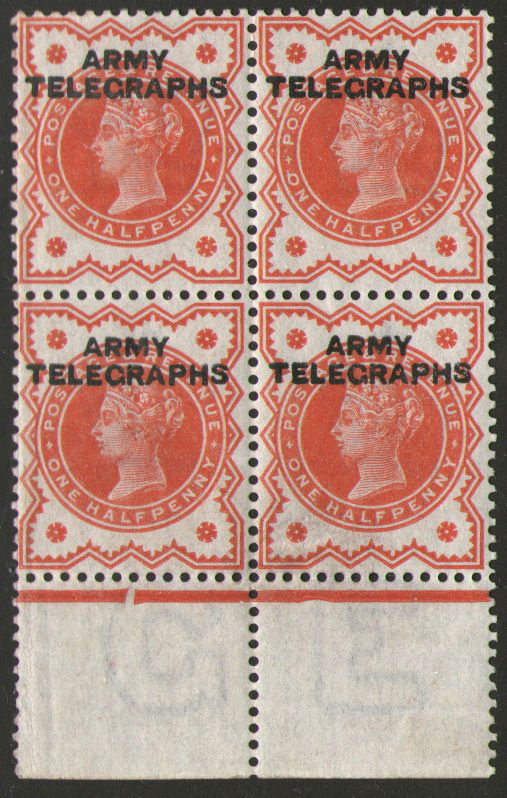 |
|
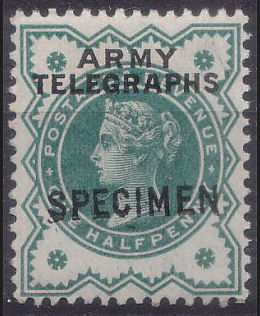 Courtesy of Steve Lawrie. |
|
| GB-H33 | GB-H35 Specimen |
Beware of forged overprints - see below.
('SPECIMEN' overprints can also be forged)
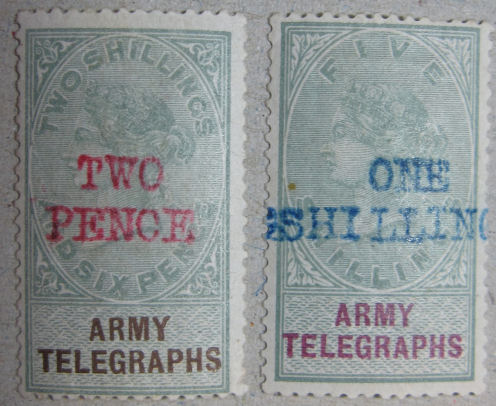
Scarce mint examples of each, courtesy of Mark Gibson. (Ex. Langmead collection)
Perf.14
| RH # | Hisc. | Description | Rarity | Mint | Used |
|---|---|---|---|---|---|
| RH47 | H47 | "TWO PENCE (vermilion) on 2s6d | R4 | 1400.00 | 650.00 |
| RH47a | * bisected on piece | Unlisted | - | 3000.00 | |
| RH48 | H48 | "ONE SHILLING" (blue) on 5s | R3 | 1200.00 | 620.00 |
| RH48a | H48a | bisected on piece | R4 | - | 2000.00 |
* These are not listed by Hiscocks
H37, H39 and H41 are known bisected from Stanley Gibbons sale Autumn 2005 lots 512-516).
See also the article by Jim Buckingham in The Anglo-Boer War Philatelist 2005, pages 88 and 89.
Examples of bisects are shown lower down on this page.
Two of the One Shilling on Five Shilling values with code MR M- dated February 1900.
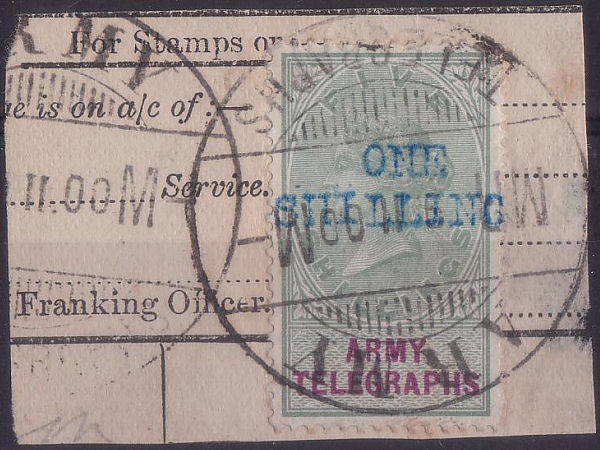
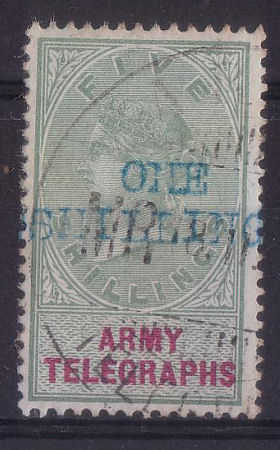
Courtesy of Steve Lawrie.
Block of four of the One Shilling on Five Shilling values, also with code MR M- dated February 1900.
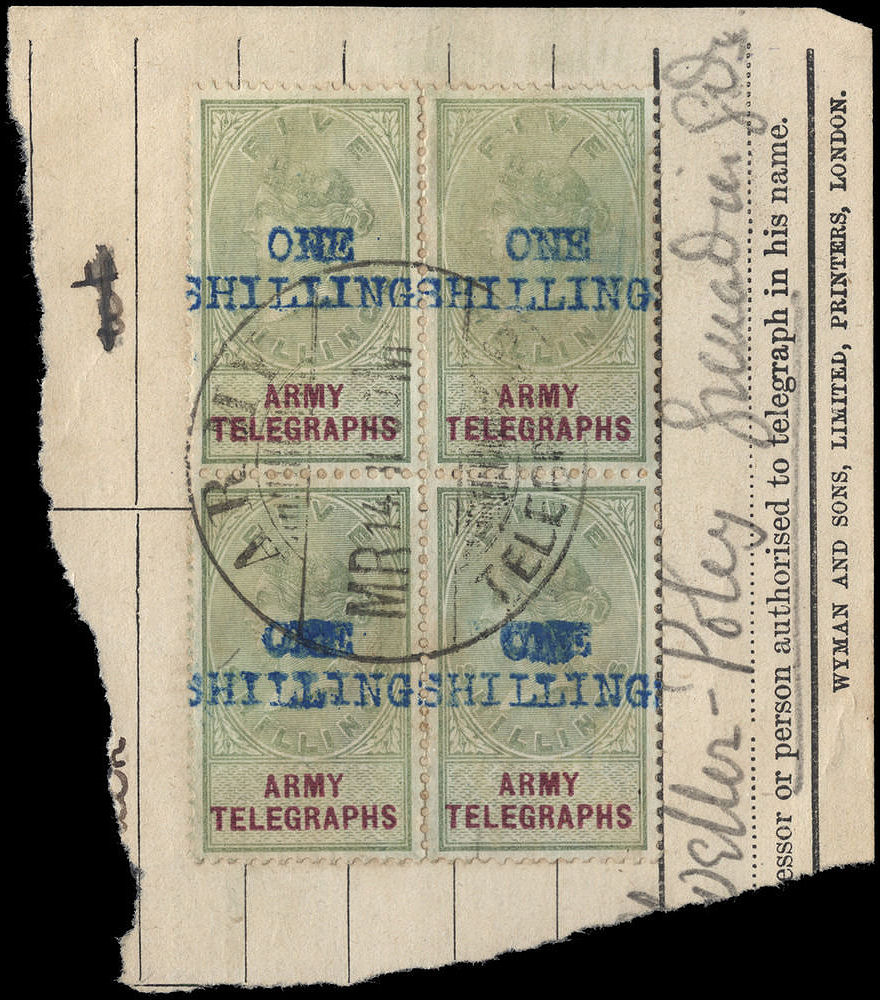
This also shows the form-printers name. Courtesy of Stanley Gibbons
Three of the One Two Pence on 2/6d values, with code E NM (Enslin Military) dated 10 February 1900.
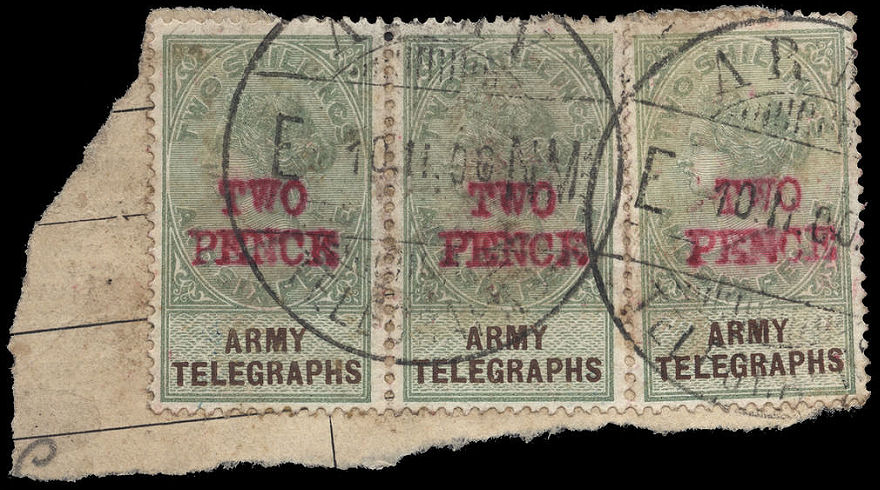
This is the last known date for Enslin Military. Courtesy of Stanley Gibbons
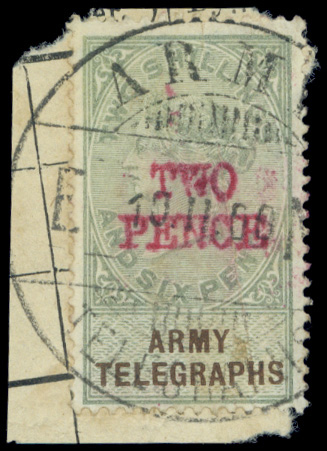 |
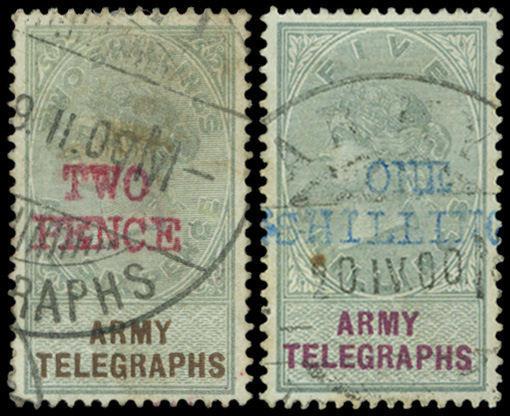 |
| GB-H47 | GB-H47 and GB-H48 |
| This illustration and the ones below are all courtesy of Grosvenor Auctions. | |
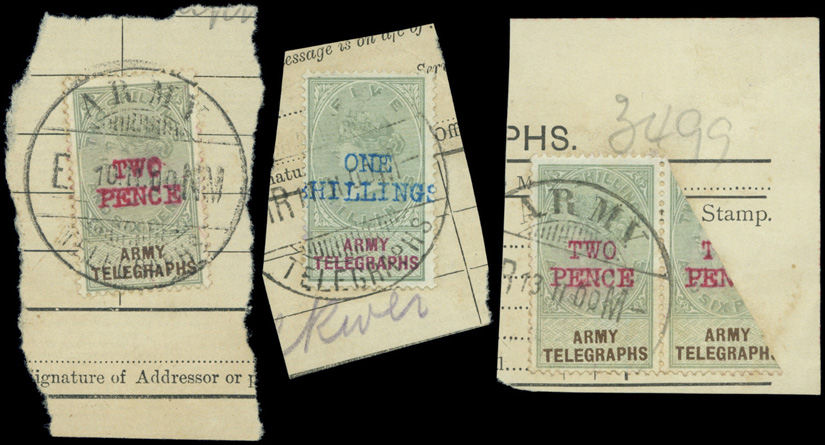 | |
 | |
| GB-47, GB-47a, GB-48 and GB-48a | |
Hiscocks lists H48 bisected diagonally on piece as H48a. The H48a above cancelled with EN 15.II.00 M has a 'D' converted to an 'O' on the overprint.
Evidence that these overprints were perhaps typed directly onto the stamps
The H47 bisected above is unfortunately not convincingly tied, however the one below is. Logically this should be referred to as H47a.
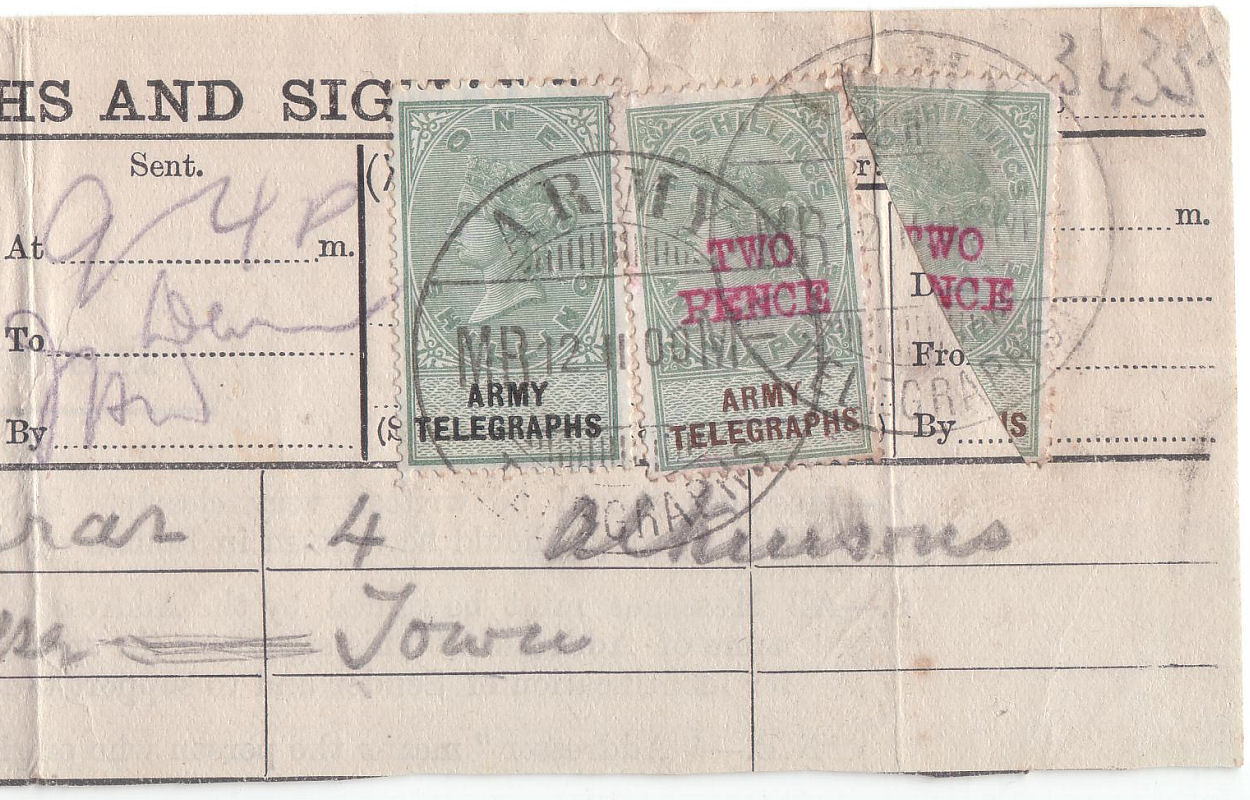
Click on it to see the full width. - Courtesy of Steve Lawrie.
This was in the Gold Coast, using stamps from 25/12/95. Most of the British troops left 8/2/96.
Some use was made after that by the few remaining (until at least July 1898 ? is suggested by L & H).
The list of stamps that L & H imply was initially sent to the Gold Coast, does not include the halfpenny shown below, so presumably there was another delivery.
L & H also say that camps were set up at Akroful, Assinie, Dunkwa, Jaykumba, Mansu, Prahsu, Suta and Yankumassi, with permanent offices at Mansu, Prahsu, Kumasi and Kwissa,
so there may be examples from other offices waiting to be discovered.
| Shortcuts to different sections: | |||
| 1896 | 1897 | 1898 | 1899 |
According to Langmead & Huggins:
The Army Manœuvres of 1896 were held near "in the neighbourhood of Aldershot from 25 August to 11 September inclusive".
For 1897 they say that Summer Exercises were held from 16 to 25 of August, but it is not explicitly stated where.
For 1898 Manœuvres they give the "vicinity of Chilmark, Bulford, Wareham and Salisbury", with
Cavalry exercises 1 July to 27 August.
Drills 15 to 31 August and
Manœuvres from 1 to 8 September.
The Royal Engineers used the telegraphic service as part of the exercises, but since most of the dates on known used copies of stamps fall outside these dates,
it is clear that much use was unrelated to the known Manœuvres. The codes may also be unrelated to the locations of the Manœuvres.
A number of codes were used, but where they were used is largely a matter of conjecture.
| Code | Known or suggested (L&H) Location | Dates known |
|---|---|---|
| A- -L | Arundel, South Downs of West Sussex | 8/9/1898 |
| G- W- | Great Wishford, Salisbury Plain ? | 6/9/1898 |
| GN B- | Glenbuck, East Ayrshire, Scotland ? | 21/5/1898 |
| R H- | Rotherham, South Yorkshire ? | 29/6/1898, 8/7/1898 |
| S B- | Salisbury ? | 6/8/1898 |
| -S -C | Stoney Castle, Pirbright, Surrey | 8/8/1912 |
| -S C- | Stoney Castle ? (see below) | 28/5/96, 21/5/98, 21/5/99 |
| S- R- | Stourbridge, West Midlands ? | 23, 28, 30/5/1899 |
| T -W | Tunbridge Wells, West Kent ? | 30/7/1898 |
| -W -R | Worcester, West Midlands ? | 4/6/1898 and 10/6/98 |
Personally, I would have thought -W -R would be more likely to be Wareham.
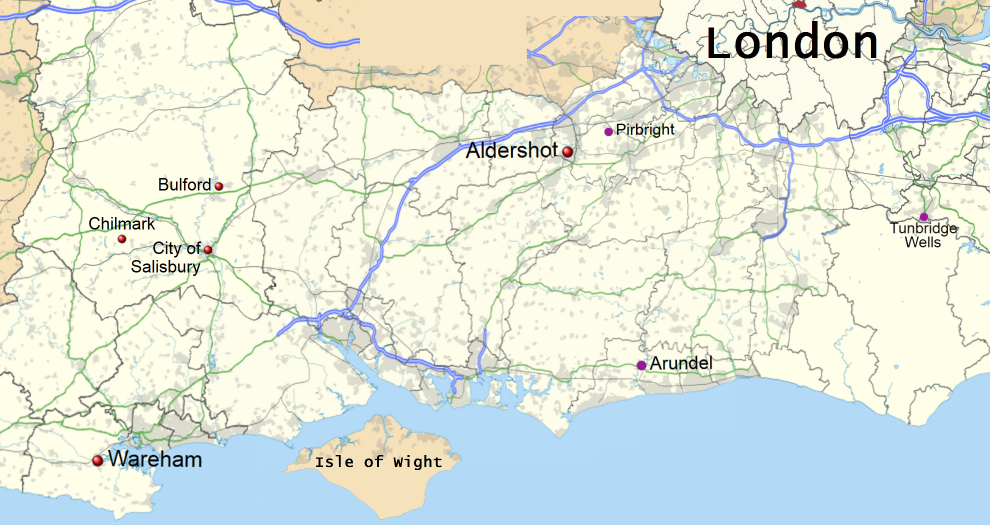
The four places indicated as the area of the 1898 Manœuvres are to the left (West) of the map above.
In the middle is Aldershot, the area stated for 1896 and the "Home of the British Army".
To the East are the three closest of the places of known use of the telegraph stamps, the others being some distance to the north.
Presumably they all communicated with each other and HQ in Aldershot, but surprisingly I do not know of any used at Aldershot.
Exercises held in the vicinity of Aldershot from 25/8/96 to 11/9/96.
Without knowing the code on the 8d, it cannot be known where it was used. It is early usage though, as these were not printed until 31/8/96.
It is clearly not code JU for Jaykumba above though, as the trip took 17 days.
The code and date on the halfpenny are not so clear. I make it ?- 30.X.96. B- but I do not know this code.
It must have been somewhere 'in the vicinity of Aldershot' though.
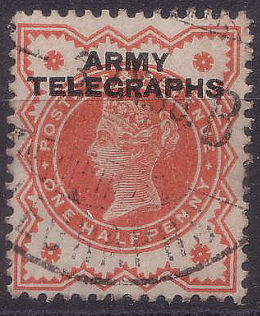
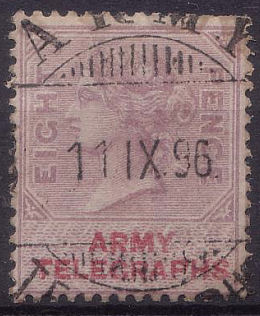
Used 3/9/96 and 11/9/96 - Courtesy of Steve Lawrie.
Exercises held from 16/8/97 to 25/8/97.
This is a scarce year. The only one I have seen, S C is currently shown below under 1898 with examples of other years.
Exercises held in the vicinity of Chilmark(Wiltshire), Bulford(Wiltshire), Wareham(Dorset) and Salisbury(Dorset) from 1/7/98 to 1/9/98.
Telegraph offices open near Wareham from 15/8/98 to 9/9/98.
Telegraph offices open near Salisbury from 24/8/98 to 9/9/98.
Telegraph offices open near Idmiston(Wiltshire) and Bulford from ? to 13/9/98.
Strangely, most of the used examples are from none of those places !
G- W- is thought to have been Great Wishford, it is on a railway line at the edge of Salisbury Plain.
they are known used on 6/9/98 on a blank 'Army Book 295 A (i).' form.
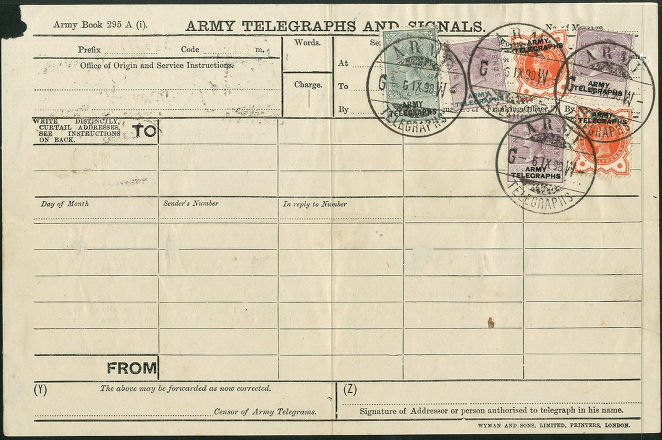
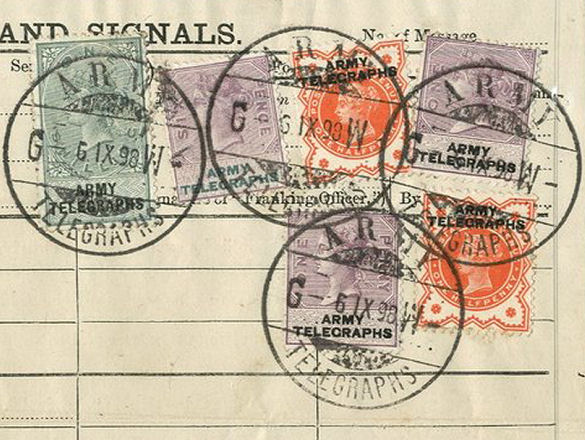
The canceller appears to be well clogged suggesting a lot of use. However this is the only example that I know of for this code. Ex Andrew Higson, courtesy of Spink & Son.
GN B- is thought to have been perhaps Glenbuck, they are known used on 21/5/98.
The halfpenny above I originally thought to be GN B- simply because it was the only known one of this period ending with B-.
Then I got the 1d stamp with the same date. In particular the strange '98'. This is clearly not GN B-.
It looks like S B-
S- R- is thought to be Stourbridge, but this could be. Alternatively this could be Salisbury (explaining why Stourbridge was S- R- rather than S B-).
That brings us to these.
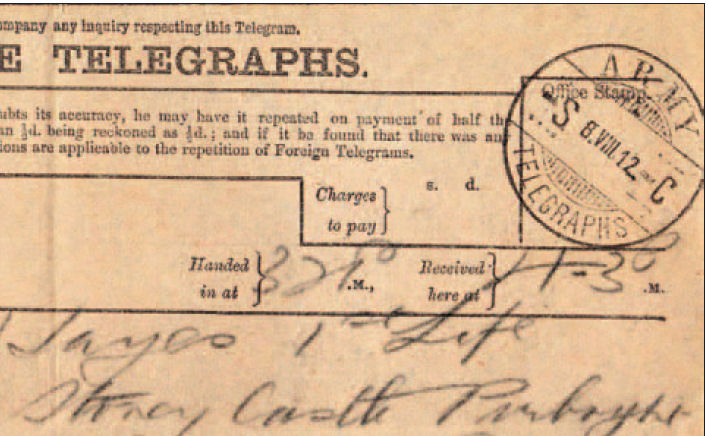
-S 8.VIII.12 -C of Stoney Castle camp, Pirbright. (Source: Andrew Higson)
But back in the 1890's, there were codes of -S C- being used, that may, or may not have been the same place:
There is a -S -C known used at Stoney Castle, Pirbright in 1912 (see above), but these are -S C- and at least three, used in May which does not fit with the Army Manœuvres dates.
Perhaps there was also a -S A- with them being simply lettered sequentially, or maybe this was Salisbury Cavalry ? We may never know.
-W -R is thought to have been perhaps Worcester, this block used on 4/6/98. In 1900 this code was used for Wepener, OFS.
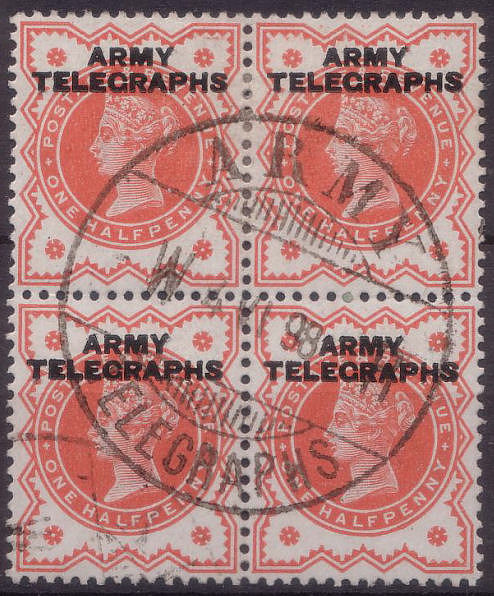
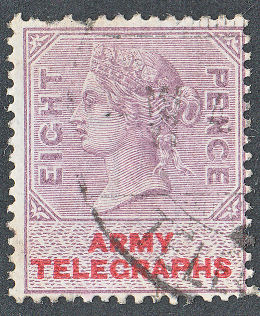
The 8d may also have been used on the same date at the same place.
and this -W -R block dated 10/6/98.
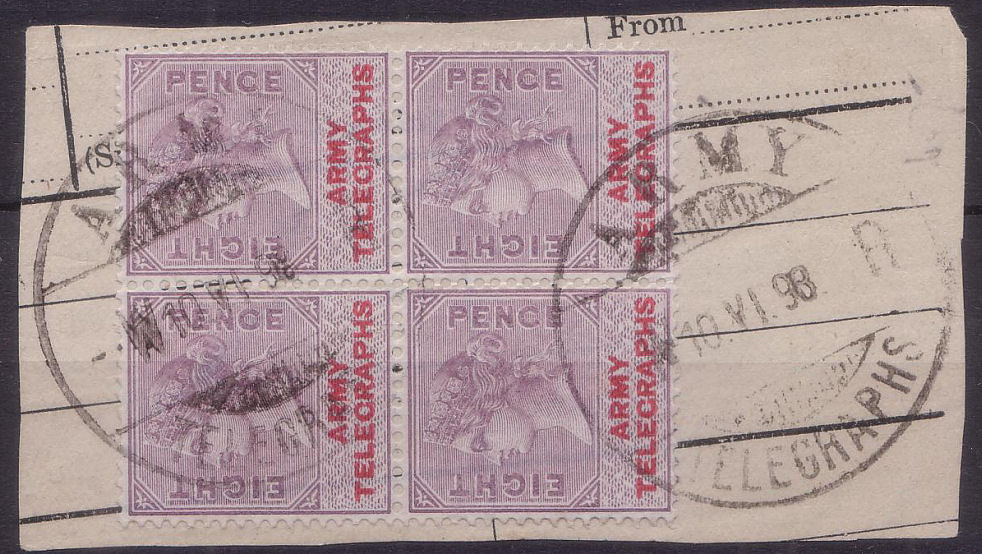
This illustration of a scarce block of GB-H40 and the block above are both courtesy of Steve Lawrie.
R H is thought to have been perhaps Rotherham, they are known used on 29/6/98.
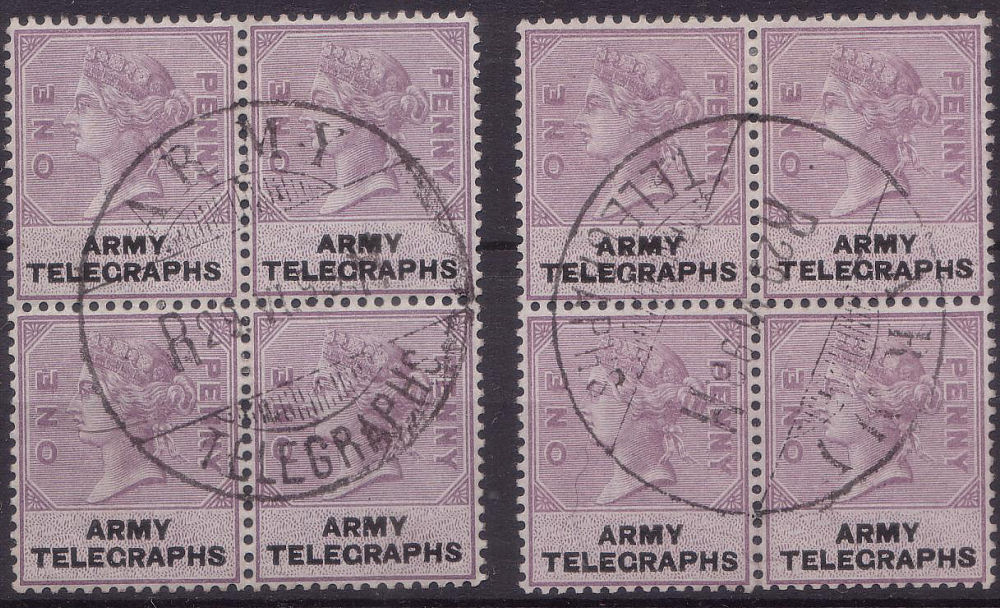
I know no other codes ending in 'H' in use on these stamps at this time. The "H" is distinctive in having the bar high up. Courtesy of Steve Lawrie.
T W is thought to have been Tunbridge Wells (though could have been Tidworth), they are known used on 30/7/98.
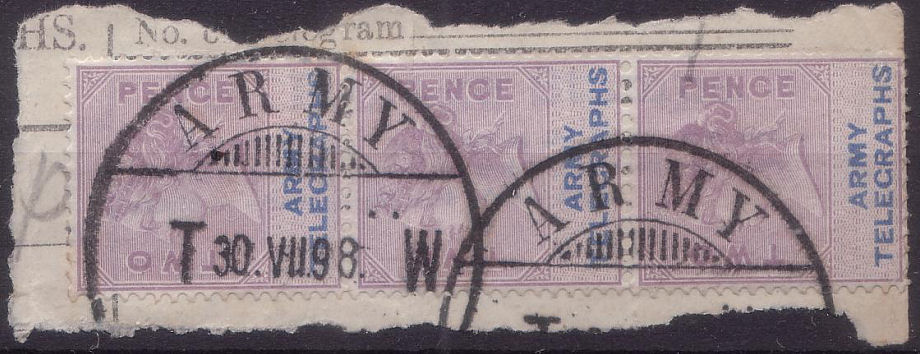
Courtesy of Steve Lawrie.
Exercises held on Salisbury plain from 26/6/99 to 29/7/99 and 31/7/99 to 2/9/99.
Do not confuse with the same stamps used during the war in South Africa.
S- R- is thought to have been Stourbridge, they are known from 23/5/99 to 30/5/99.
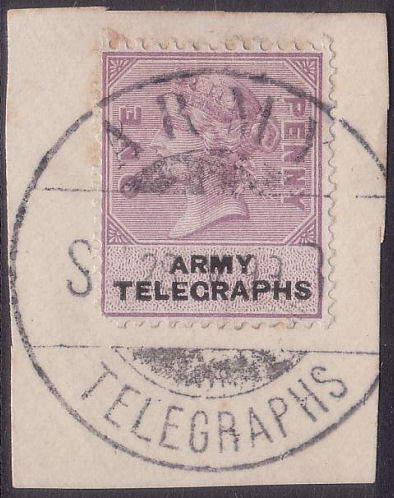 |
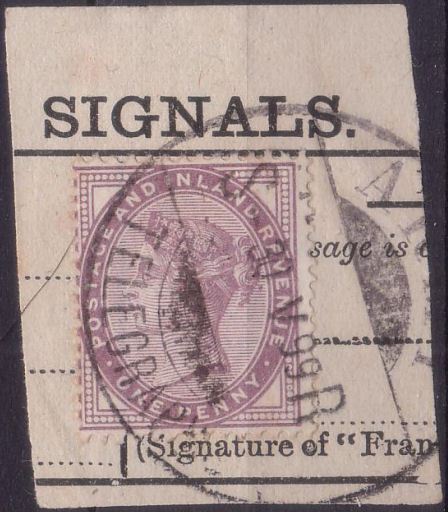 |
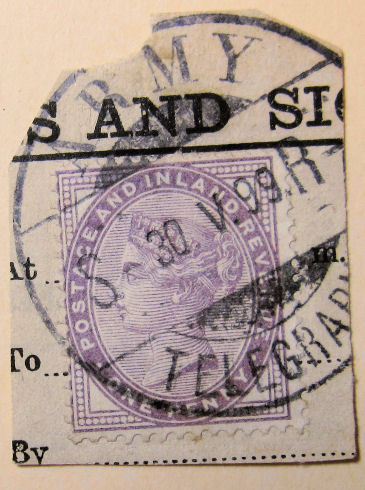 |
| A 1d Army Telegraphs, dated 28/5/99 | A GB 1d lilac, dated 30/5/99 | A GB 1d lilac, dated 30/5/99 |
| Courtesy Steve Lawrie. | Courtesy of Mark Gibson. | |
They appear to have run out of the Army Telegraph stamps and resorted to postage stamps. The handstamp is well clogged, suggesting heavy usage.
Here is another well-clogged example courtesy of Steve Lawrie.
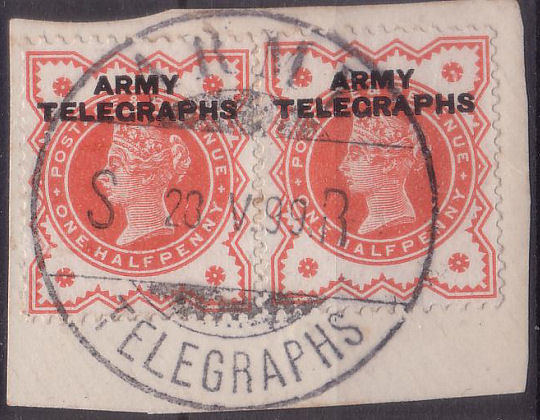
Be aware that the code -S -R was used during the Anglo-Boer war in South Africa from March 1900.
For an in-depth description of the Telegraph and Telephone operations see History of the Telegraph Operations during the war in South Africa, 1899-1902 by Liet.-Colonel R. L. Hippisley, C.B., R.E.
These stamps were used in Cape Colony, Natal and Transvaal, but by the time they got to the Transvaal and Orange Free State they had just about run out of these stamps.
They then used 'liberated' local stamps which I cover under Army Telegraphs 2
| Shortcuts to different sections: | |||||
| Cape Colony | Natal | Transvaal | Orange Free State | Bechuanaland | Basutoland |
According to Hippisley (page 5):
"On the 15th November [1899] one of the Colonial wires north of De Aar was handed over to the military for use as occasion might suggest for the military offices.
De Aar was made the handing over office between the Civil and Military Administrations. It was agreed that the Army Telegraphs should be treated as one of the signatories of the South African Telegraph Convention of 1886,
retaining as revenue all money received for private telegrams at military offices which were authorised to transmit paid work, and even at those within the Colony where there were no existing postal telegraph offices."
He also said (page 5):
"Subsequently, as the military operations developed, more Colonial wires were lent to the Army Telegraphs. Eventually they had for their own exclusive use four wires between De Aar and Modder River,
three from Modder to Kimberley, three thence to Mafeking, one from De Aar to Naauwpoort, one from Naauwpoort viâ Stormberg to Bethulie, and two from Naauwpoort to Norvals Pont."
Though Hippisley gives a list of offices with opening and closing dates, it makes no mention of the telegraph codes used, or even the stamps.
Associating the codes with office names/locations is sometimes based on hard evidence, but has also been done by guesswork.
The evidence shows that either the list is incomplete, and/or some guesses are wrong.
Keep in mind that Hippisley left in 1902, before many of the offices closed, and probably before some opened.
| Code | Location | Opened | Closed | Dates known |
|---|---|---|---|---|
| -ALN | Arundel Military | 07/12/1899 | 17/03/1900 | 15/2/1900 - 21/2/1900 |
| BT M- | Belmont Military | 23/11/1899 | 05/07/1900 | 15/12/1899 |
| DA M- | De Aar Military | 19/11/1899 | 10/06/1900 | 4/12/1899 |
| E- NM | Enslin Military | 26/11/1899 | 20/09/1900 | 22/1/1900 - 10/2/1900 |
| EN M- | Enslin Military ? | 26/11/1899? | 19/11/1900 | 15/2/1900 - 16/2/1900 |
| MR M- | Modder Military | 29/11/1899 | 04/05/1900 | 2/12/1899 - 22/2/1900 |
| NP M- | Naauwpoort? Norvals Pont? | - | 02/06/1900? | 13/3/1900 - 7/5/1900 |
| -P -R | Porters Hill | 03/01/1900 | 02/03/1900 | 13/1/1900 |
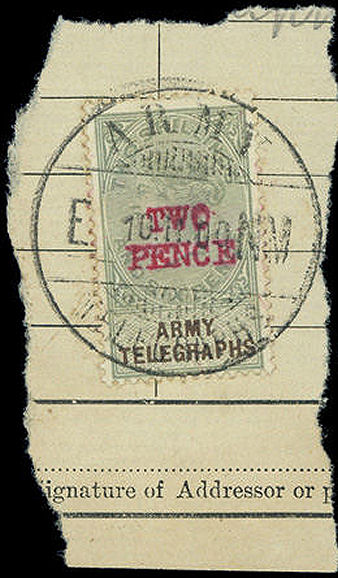 |
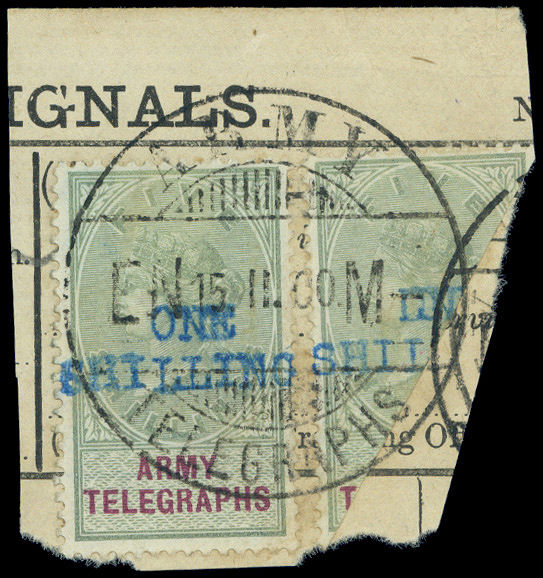 |
| E 10.II.00 NM of Enslin | EN 15. II.00 M- also thought to be Enslin |
| Courtesy of Grosvenor Auctions. | |
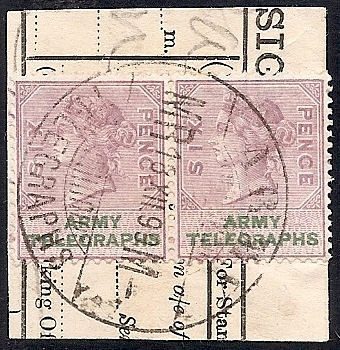 |
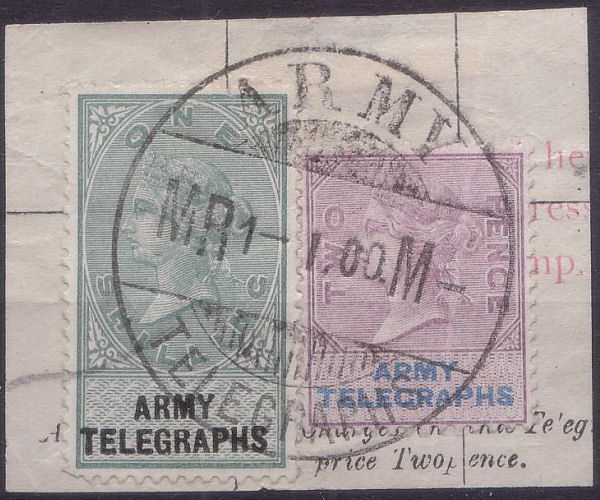 |
| MR 18.XII.99 M- of Modder Military | MR 1- I.00 M- of Modder Military |
| image courtesy of Brian Fenemore | courtesy of Steve Lawrie |
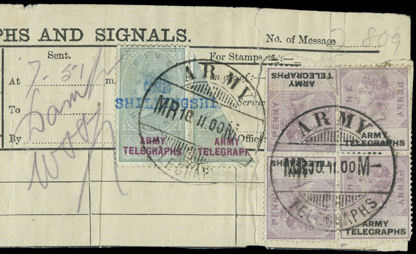 |
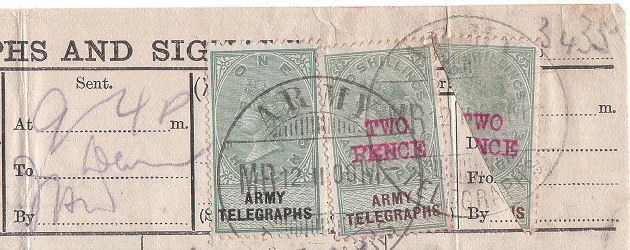 |
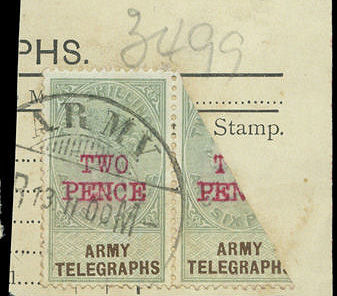 |
| MR 10.II.00 M- of Modder Military #2809 | MR 12.II.00 M- of Modder Military #3435 | MR 13.II.00 M- of Modder Military #3499 |
| Courtesy of Grosvenor Auctions. | Courtesy of Steve Lawrie. | Courtesy of Grosvenor Auctions. |
| These 3 snippets provide a rough measure of the numbers of messages being sent. They are from Modder Military over a 4-day period in February 1900 and show the message number in the top-right corner. We do not know the times of the messages (though you may be able to decipher two of them), but if message 2809 was sent on the 10th and message 3499 on the 13th then it indicates about 230 messages per day. If each needs an average of 2 stamps then this is about 460 stamps per day from this office alone. This explains why surcharges and bisects were being used by this time to supply more low-value stamps. |
||
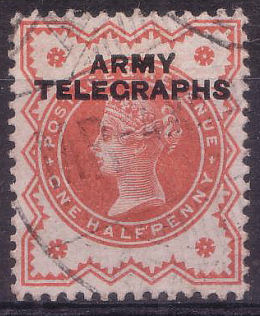
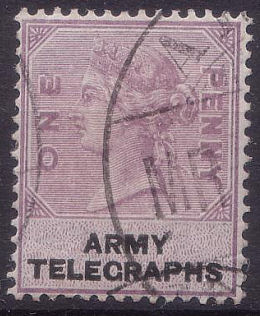
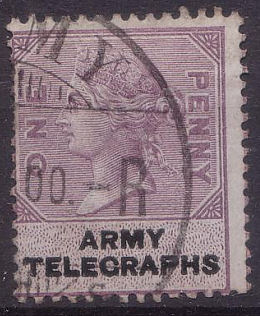
Modder did start out with low values. The list of printings given by L & H in preparation for the war does not include them,
but clearly left-over stock was available. The last stamp above may have been used at Porters Hill. Images courtesy of Steve Lawrie.
The block below shows that lower value stamps were sacrificed to replace shilling stamps.
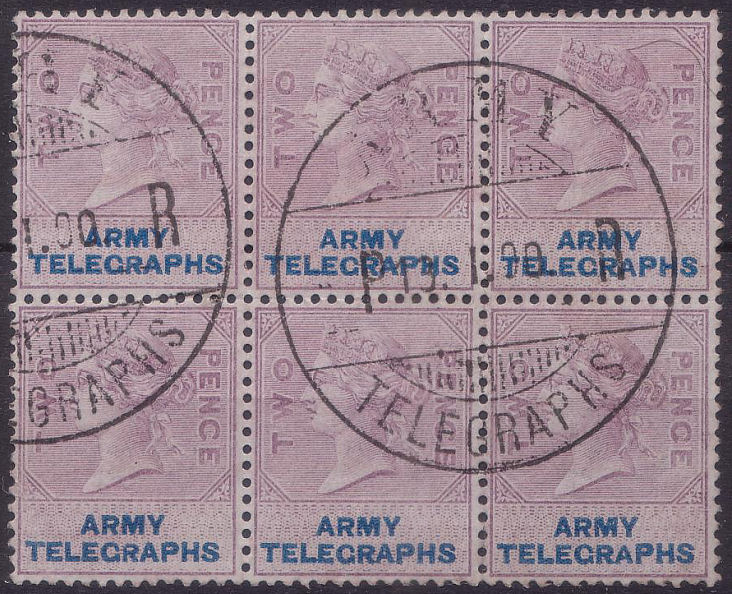 |
| Quantities of low values used to replace shilling stamps. -P 13. I.00 -R of Porters Hill |
| courtesy of Steve Lawrie |
Useful maps can be found on PineTreeWeb and AngloBoerWar.com.
| Code | Location | Opened | Closed | Dates known |
|---|---|---|---|---|
| C- HO | *Cookhouse ? Chieveley Hospital ? | ? | ? | 4/5/1900 |
| C- M- | Chieveley Military | 5/2/1900 | 13/11/1900 | 13/2/1900 |
| F C- | Frere Camp | 10/1/1900 | ? | 17/1/1900 |
| F- E- | Frere | 10/1/1900 | 01/3/1900 | 1/2/1900 |
| H- F- | Hydes Farm | ? | ? | 6/5/1900 |
| H Q | Buller's HQ (moved about) | 10/1/1900 ? | ? | 16/4/1900 - 19/7/1900 |
| I- G- | Ingogo Hill | 19/5/1900 | 6/6/1900 | 19/7/1900 - 20/7/1900 |
| L- D- | Ladysmith | 1/3/1900 | 31/5/1900 | 23/4/1900 - 6/5/1900 |
| M- -S | Modderspruit | 5/3/1900 | 7/5/1900? | 31/3/1900 - 12/5/1900 |
| -S F- | Spearmans Farm | 12/1/1900 | 10/2/1902? | 2/2/1900 |
| -S -R | Elandslaagte (Sundays River) | 9/3/1900 | 18/5/1900 | 23/3/1900 - 7/4/1900 |
| PM PM | Pietermaritzburg | 3/6/1901 | ? | 4/6/1901 - 7/6/1901 |
* Although HO is often an indication of 'Head Office' it was plausibly suggested that this was actually Cookhouse. The suggestion has now been withdrawn. Any ideas ? The date suggests somewhere near Ladysmith.
Perhaps 'HO' was for hospital, there was Clanwilliam Hospital in the Western Cape attached to the blockhouse system, maybe this was Chieveley Hospital.
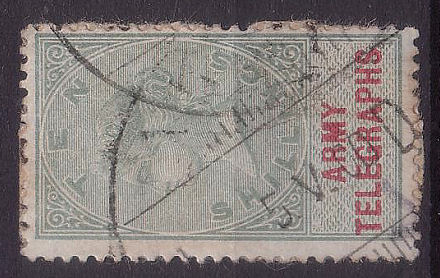
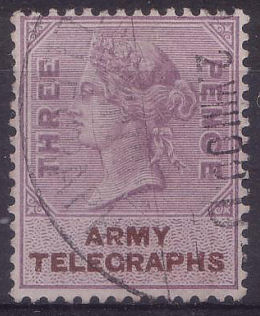
L- 5.V.00. D- (probably) and L- 2.VIII.00. D- (probably) Ladysmith. Courtesy Steve Lawrie.
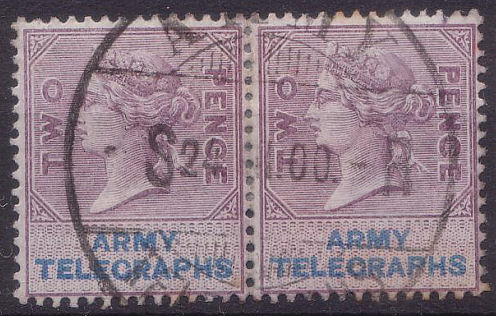 |
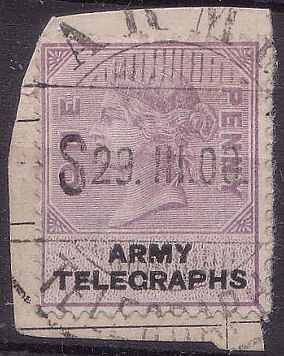 |
| -S 24.III.00.-R Elandslaagte (Sundays River), Natal | -S 29.III.00.-R Elandslaagte, Natal |
| Courtesy of Steve Lawrie. | |
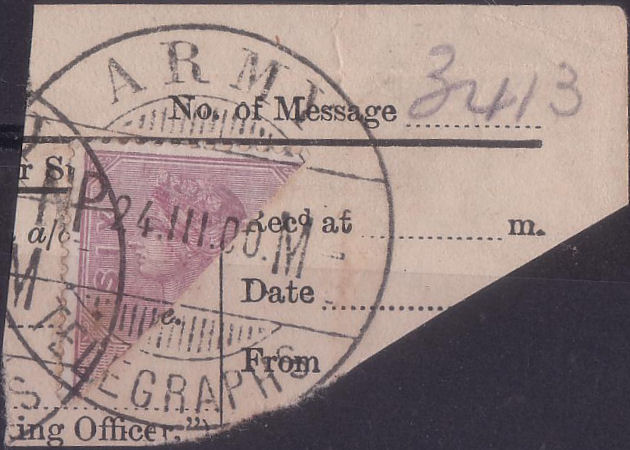
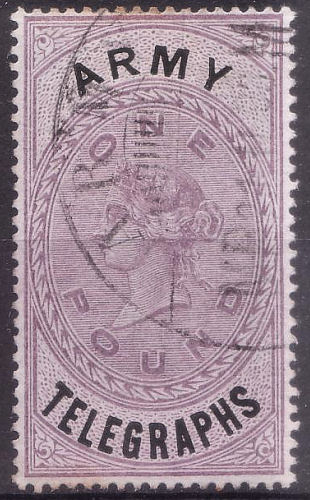
NP 24.III.00. M- Naauwpoort? or perhaps Norvals Pont? Courtesy of Steve Lawrie.
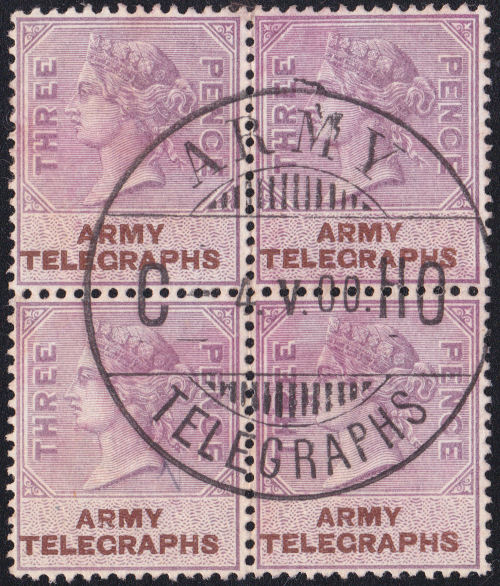
C- 4. V. 00. HO Cookhouse? or perhaps Chieveley Hospital?
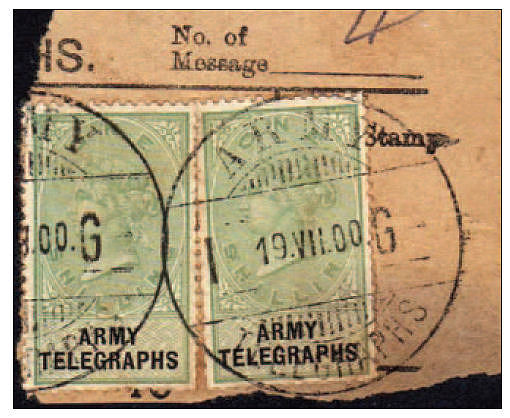 |
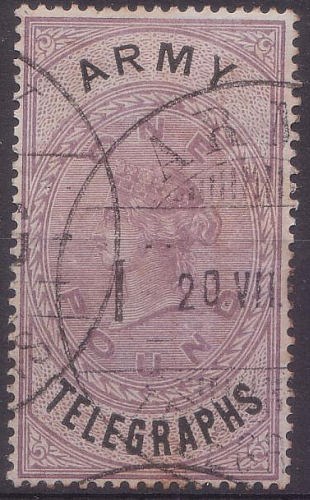 |
| I- 19.VII.00.G- Ingogo Hill, Natal Courtesy of Andrew Higson. |
I- 20.VII.00.G- Ingogo Hill, Natal Courtesy of Steve Lawrie. |
| Code | Location | Opened | Closed | Dates known |
|---|---|---|---|---|
| -P K- | Paardekop | 21/6/1900 | ? | 2/8/1900 - 4/8/1900 |
| PG PG | Pietersburg | ? | ? | 20/6/1902 |
| S- N- | Standerton | 22/6/1900 | ? | 1/8/1900 - 28/4/1902 |
| -S -N | Standerton H.Q. | 25/6/1900 ? | 21/7/1900 ? | 25/6/1900 - 28/3/1901 |
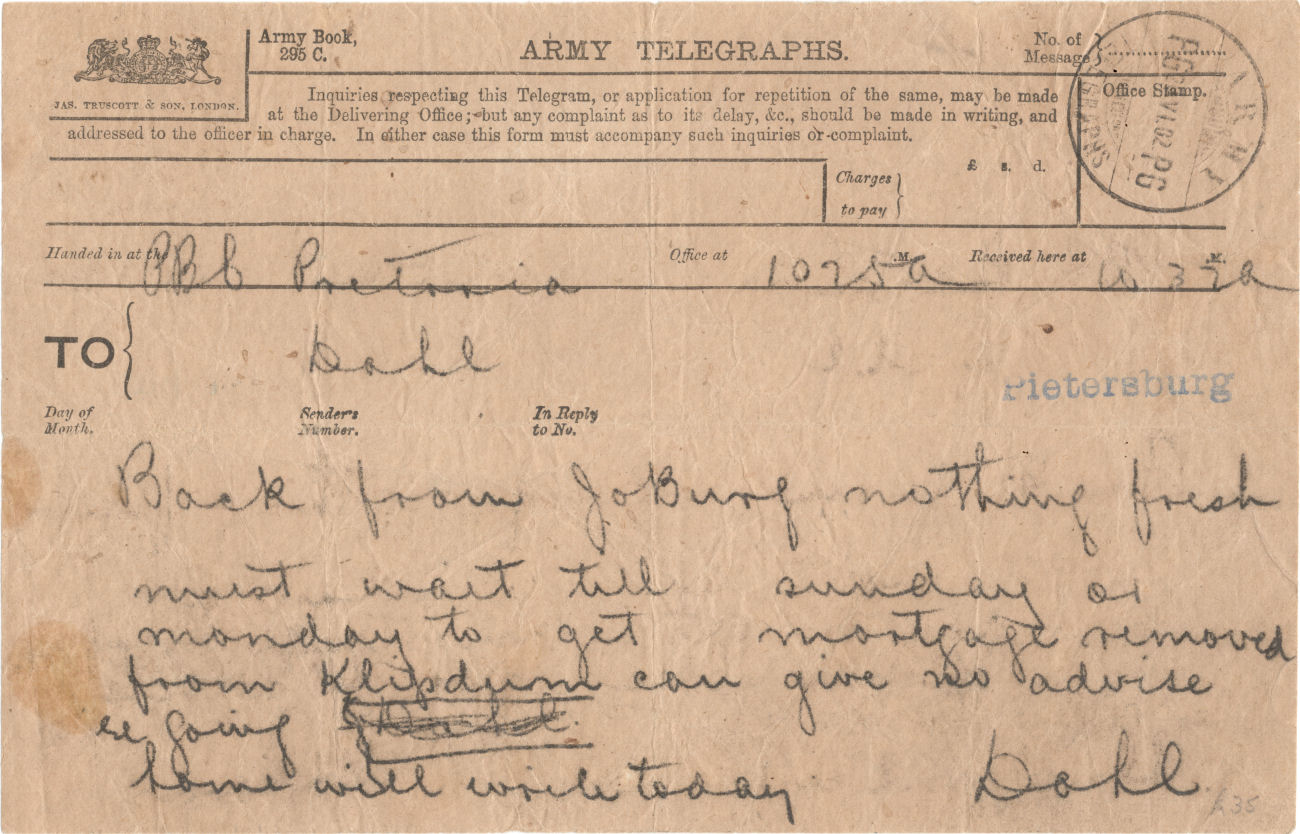
Army Book, 295 C. Form, message sent from Pretoria to Pietersburg stamped PG 20.VI.02 PG - courtesy if Ian Paterson.
There are many other offices known in the Transvaal that used stamps of the South African Republic due to a lack of these British Army Telegraph stamps.
This includes Johannesburg and Pretoria. They can be seen on the Army Telegraphs 2 page.
As with the later telegrams of the Transvaal, these only seem to have used stamps of the Orange Free State, or later, those of the Orange River Colony.
They can be found on page 2 here.
Bechuanaland was a British Protectorate, and the only examples that I've seen of Army Telegraph use (so far) in Bechuanaland were used either at Ootsi (Outsi)
on May 15th and 16th of 1900 using stamps of the Bechuanaland Protectorate, or a single example at Mafeking on 7/12/1900 on a cover to England, bearing Cape stamps.
They can be found on page 2 here.
During this period, Basutoland was a crown colony administered by Britain and supposedly neutral.
It did though happily accept many Boer refugees, together with their livestock to help the war effort, by depriving Boer fighters of the resources.
Additionally, apparently Refugees’ farms were also often exempted from the scorched earth policy of the British forces.
I have not though seen evidence of Army Telegraph Offices being opened there.
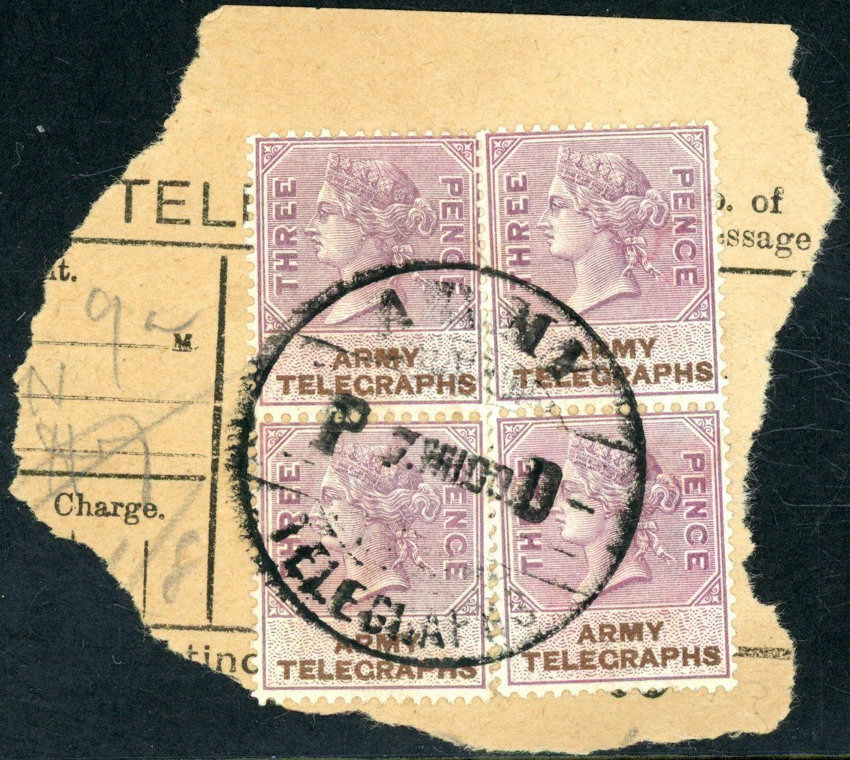
This is cancelled -P 7.VIII.00.D- and the date suggests somewhere in the Transvaal, but the exact location is unknown.
They appear to have been there long enough to have run out of one shilling stamps.
This image and the one of 9 days later shown below are courtesy of Peter and Marie (bygonesofbridlington on eBay).
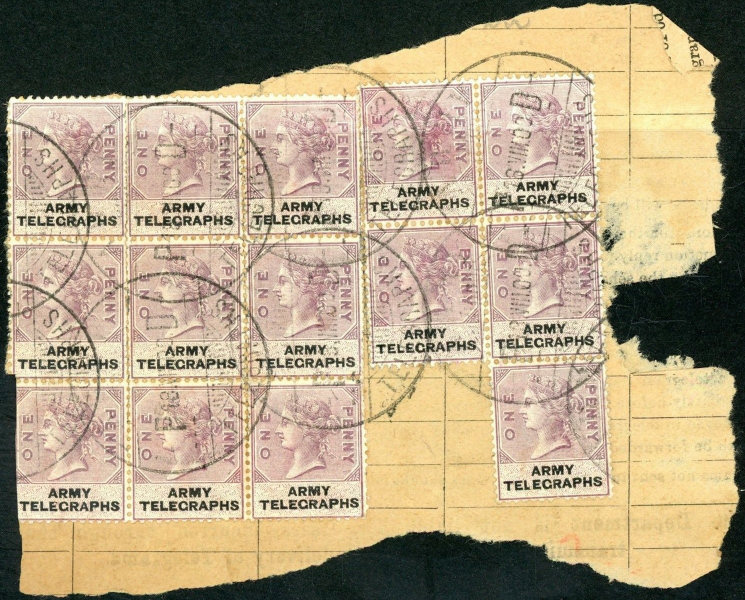
Though feint, this is cancelled -P 16.VIII.00.D- It looks like after 9 days they had run out of 3d stamps too.
This image is half my normal size, click on it for a larger version.
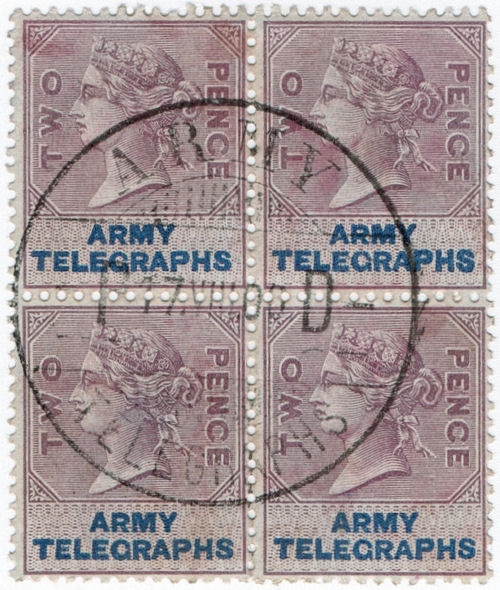
Next day they found some 2d stamps.
-P 17.VIII.00.D- - courtesy of ibredguy.co.uk (click image for listing)

This image is half size, click it for a full size version.
This item is doubly unknown. This unknown code R- GM is known on another item dated 7/2/1900, the item below (9/2/00) and on this dated 5/1/1900.
In addition, its current whereabouts are unknown, missing or lost.
It was recently purchased from Stanley Gibbons, but was not in the tamperproof package when it arrived in Australia.
It is very distinctive with 11 x 2s6d stamps.
If anyone should see or hear of this item, please contact either myself (contact details below),
![]()
This looks like a Cape of Good Hope Post Office Telegraphs form.
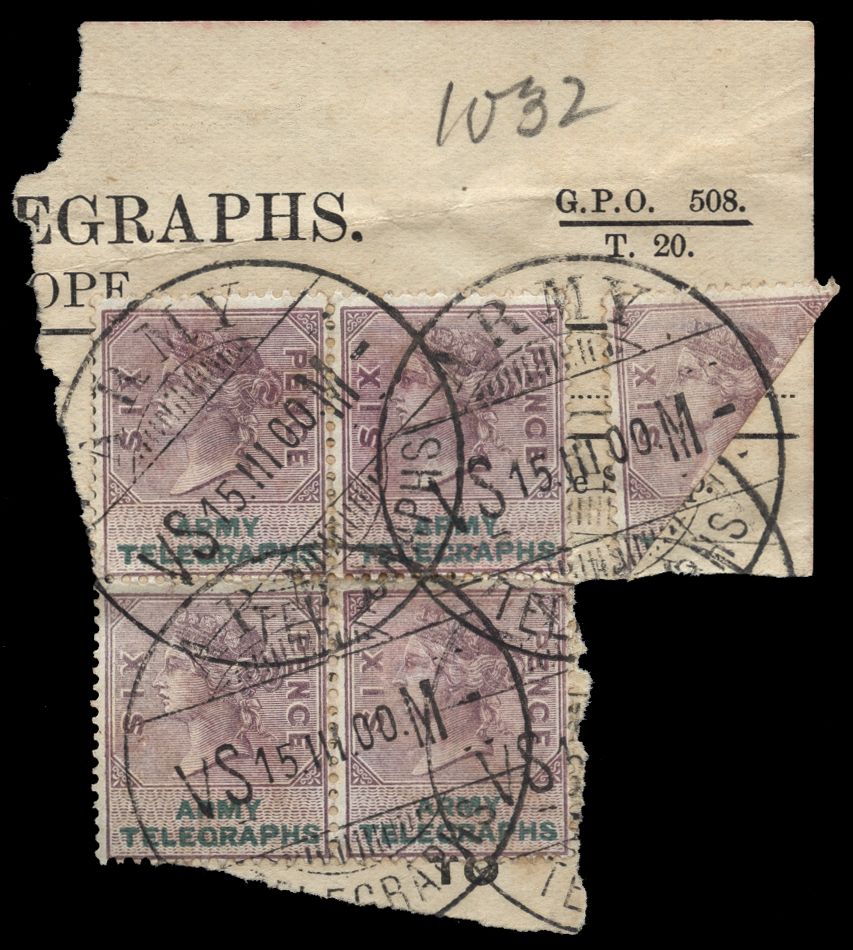
VS 15.III.00. M- Unknown location. Courtesy of Mark Gibson.
If it is assumed that the 'unknowns' were used in Natal or Transvaal, an idea of the location may be gained from the date.
However it has to be remembered that short-lived locations in Bechuanaland or the Orange Free State are also possibilities.
In Bechuanaland, the code O- -S (all on the left) is known used at Ootsi on 15/5/00. In OFS, local stamps were being used by then.
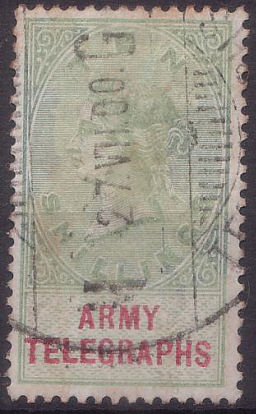 |
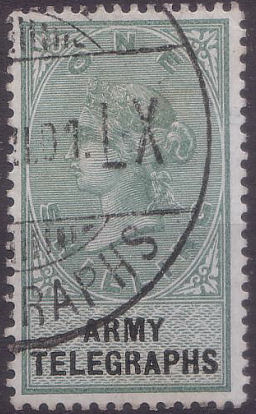 |
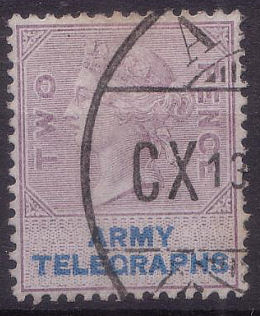 |
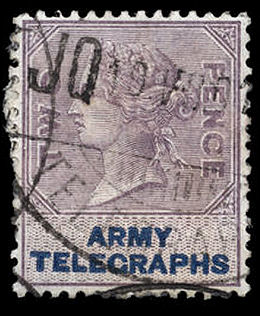 |
| M 27.VII.00 G of ? | 1901 LX of ? | CX 13.?.? ? of ? | JQ or perhaps JO, either way unknown. |
| courtesy of Steve Lawrie. | Courtesy of Stanley Gibbons. | ||

Andrew Higson first found the 'Specimen' 2d shown above with a flaw on the 'Y' and kept an eye open for other examples to see if it was constant.
He subsequently found the same flaw on a halfpenny stamp shown below.

for convenience I have added the new 'ARMY TELEGRAPHS' overprint with wider 'ARMY' below for comparison.
Note that in 'TELEGRAPHS' the letters are narrower with wider spaces and the 'G's are different.

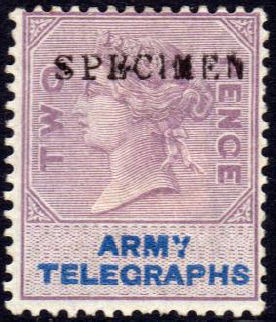 |
In addition to the obvious 'Y' flaw,
|
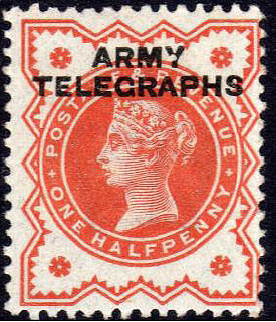 |
I would say that this is very conclusive evidence that the same forme was used. Since the unappropriated stamps were in sheets of 120 and the halfpenny in sheets of 240, I would presume that the latter sheets were each divided into two sheets of 120 for the overprinting. It can therefore be expected that this flaw should be on 1 out of every 120 of the stamps on affected sheets. This means there are two positions on a sheet of the halfpennies that this can occur on. |
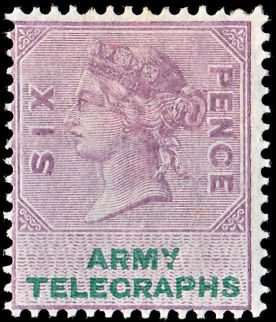 |
|
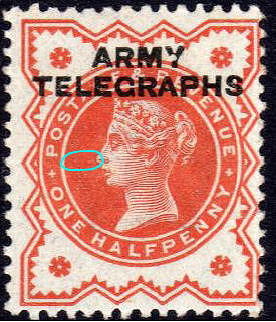 |
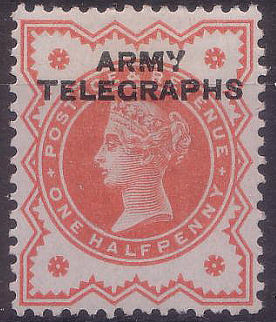 |
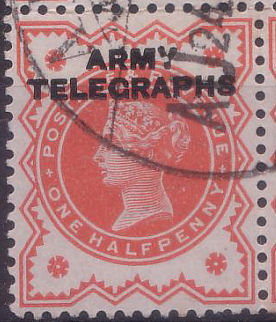 |
Here are another two examples courtesy of Steve Lawrie. There seems to be some similar blemishes to the left of the nose on one stamp. The other does not. This may help to identify the locations on a sheet. |
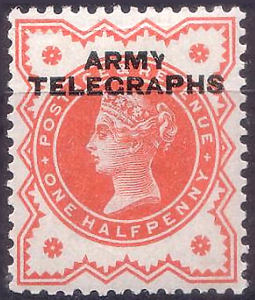 Another variety with a broken 'Y' It is worth looking out for on all the low values. Image courtesy of Steve Lawrie. |
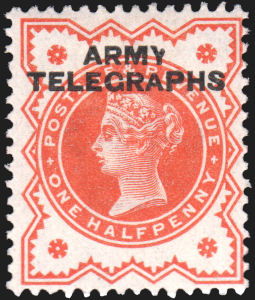 Another example with the same broken 'Y' . Image courtesy of Ricky Verra. |
This 'Y' seems to have had a lot of problems.
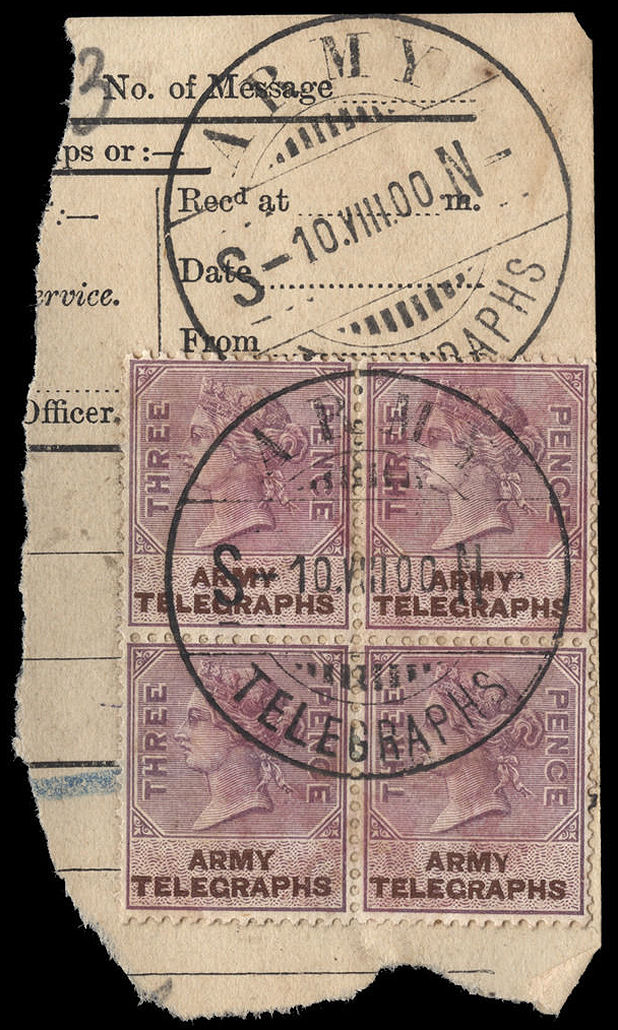
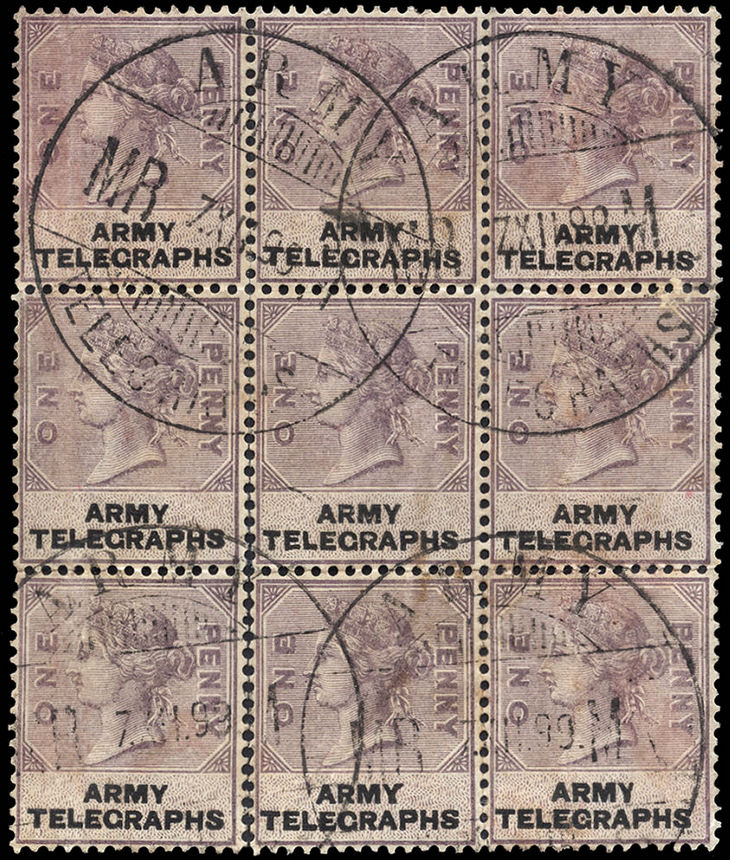
The bottom two 3d here also have constant varieties.
Compare to the right-hand pair of the bottom row of the 1d block. - These two blocks courtesy of Stanley Gibbons
The pair below shows the same pair of flaws on halfpenny stamps.
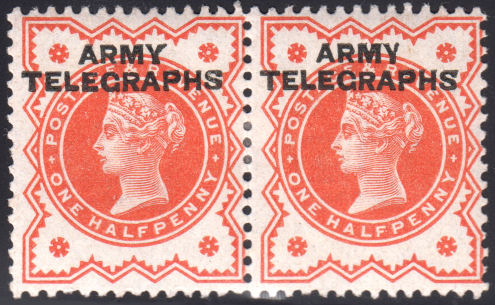
Image courtesy of Ricky Verra
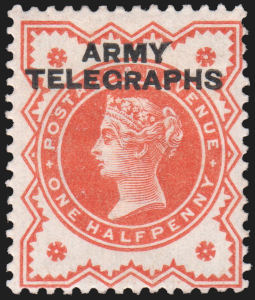 Similar to the one above but the stem of the 'Y' is different. |
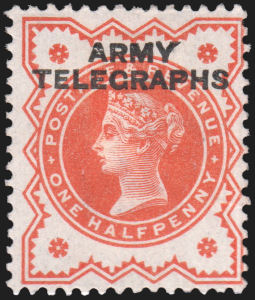 Similar to the last one but the left arm of the 'Y' is truncated. |
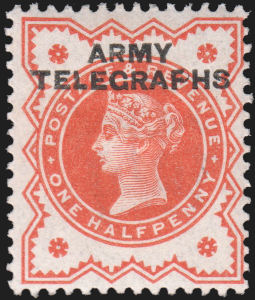 This has a broken 'P' and a bite out of the 'L'. I don't know if it is constant. Anyone have another example ? |
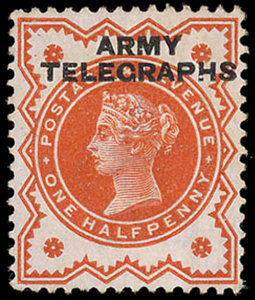 This has a broken 'H' and a bite out of the 'M'. (click on image for listing) |
| Images courtesy of Ricky Verra. | Courtesy of Schuyler Rumsey Auctions. | ||
Whilst on the subject of these overprints, Mark Gibson remarked that he thought that a lot of these were fakes.
I had a look at mine. At the top is a presumed genuine unappropriated die 1d and below that is a halfpenny vermilion.
If you look closely, the letters (which are formed by impact) have a pale edge surrounded by a darker 'splash zone'.
If you look at the halfpenny green there is no sign of that and the edges are very ragged. I would take this to be a fake.




Additionally the same is true with these as with the GB Official overprints. Look at the back.
On the vermilion the overprint can be seen clearly from the back.
There may be better fakes around, but this at least can be looked for
It has recently been pointed out to me that the forged overprints tend to be slightly slanted.
I am actually finding it hard to get a good image of H34 when looked at closely.
Can anyone send me a good(600dpi+), convincing image of H34 ?
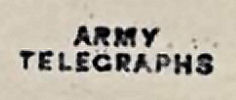
Here is an example of Fournier's work. The small 'G' and slanted 'Y' are a giveaway. He also forged the GB Official overprints.
Image courtesy of James Bendon who has many more Fournier examples for sale.
(Click on image to see source).

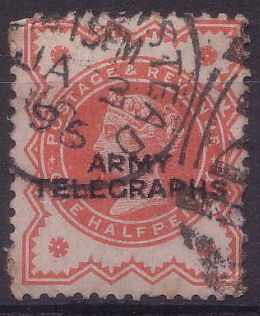
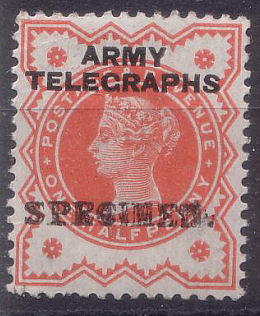
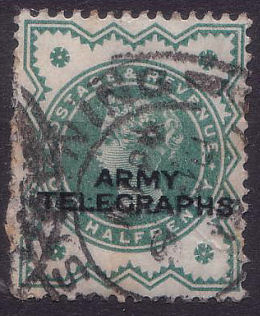
Apart from being in the wrong place, these two are very rough compared to the genuine stamp in the centre.
There seems also to be a short hyphen after the 'L' of 'TELEGRAPHS'.
Images courtesy of Steve Lawrie.
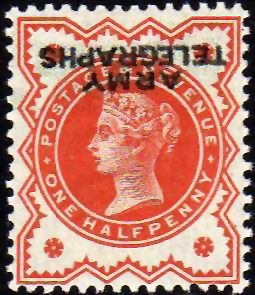
A giveaway on this one is that 'ARMY' is the later overprint type, although 'TELEGRAPHS' has
letter width/spacing like the early type, with a bar added to the 'G'. It also looks rather rough.
Courtesy of Andrew Higson.
All recorded types are illustrated. Anyone have any new types ?
Here is a couple of 6d bisects, they all seem to have the code NP M- February or March 1900.
 |
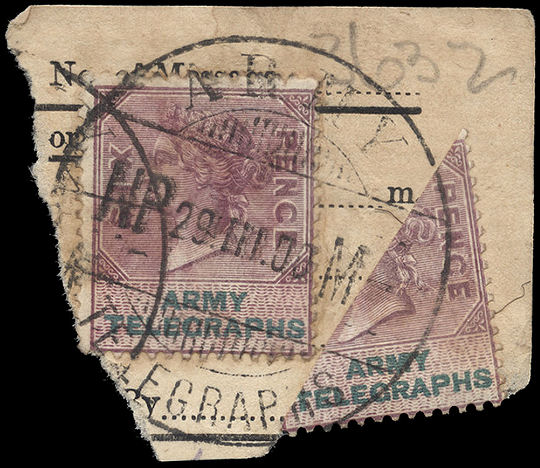 |
| 6d bisected - RH39a - NP M- dated 24/3/00, Message number 3413. | 6d whole and bisected - NP M- dated 29/3/00, Message number 3632. |
| Courtesy of Steve Lawrie. | Courtesy of Stanley Gibbons. |
These two are used in the same place 5 days apart. The difference in message number of 219 suggests about 44 messages per day.
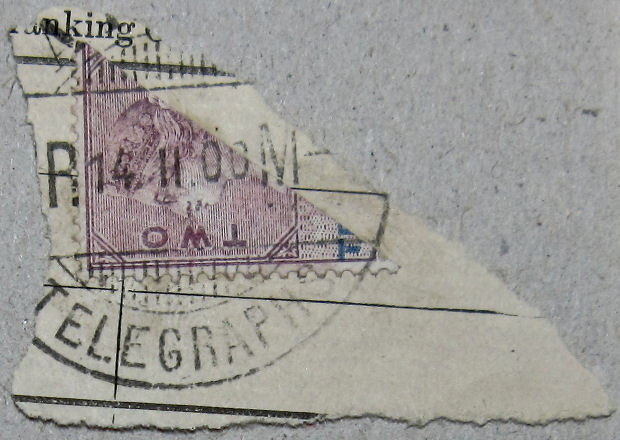 |
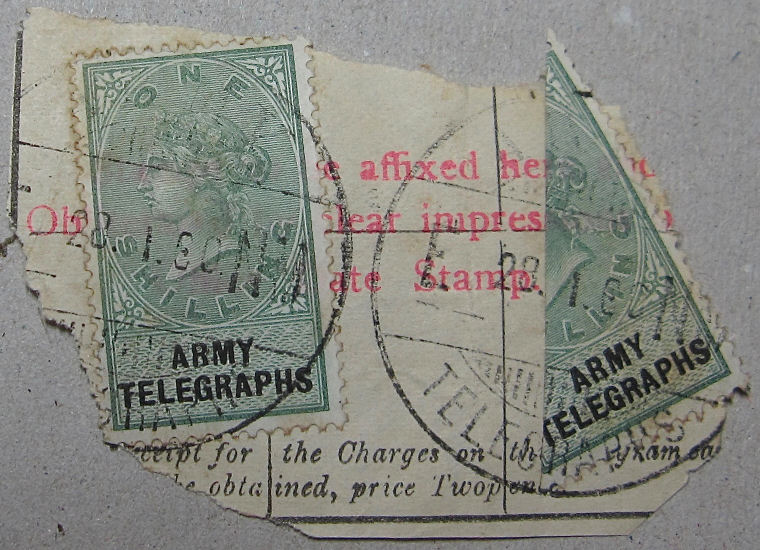 |
| 2d bisected - RH37a | 1s whole and bisected GB-H41 and H41a |
| Courtesy of Mark Gibson. | |
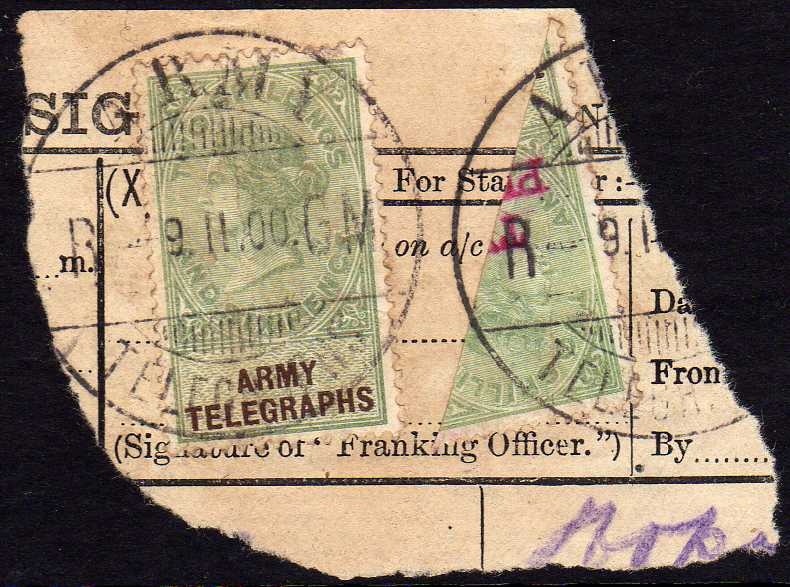 |
 |
| 2s6d - GB-H42 and 'TWO PENCE' on 2s6d bisected - RH47a | "ONE SHILLING" on 5s GB-H48 and bisected GB-H48a |
| Source: Andrew Higson. | Courtesy of Grosvenor Auctions. |
The cancellers used for these were manufactured by the small Swiss firm of Güller and Sons in Hüttikon.
This was due to the success of J.J. Güller in providing the Swiss Post Office with a new type of canceller having revolving wheels in place of date plugs.
In 1887 the British Army placed their first order with Güller, who continued to receive orders until 1915.
In that time Güller supplied a total of 1515 cancellers, 475 of which were supplied in 1915 after which supplies from them ceased, no doubt due to WWI.
Subsequent cancellers were inscribed 'Army / Signals' reflecting a change of name that happened officially in 1910.
Initially these were the same diameter steel, but shortly after (end of 1916) a 10mm larger diameter type, seemingly of rubber was used.
The Swiss 'Army Telegraphs' type continued to be used until at least 1941. The new 'Army Signals' type was used until at least 1946.
Lt. Col. R.L. Hippisley reports that during the South African campaign (second Anglo-Boer War 1899-1902) 1,047 telegraph offices
were operational at one time or another, but that only 147 of these were ‘permanent’.
This information is from an article written by Andrew Higson FRPSL and Michael Rutherfoord. It appeared in the London Philatelist of May 2011.
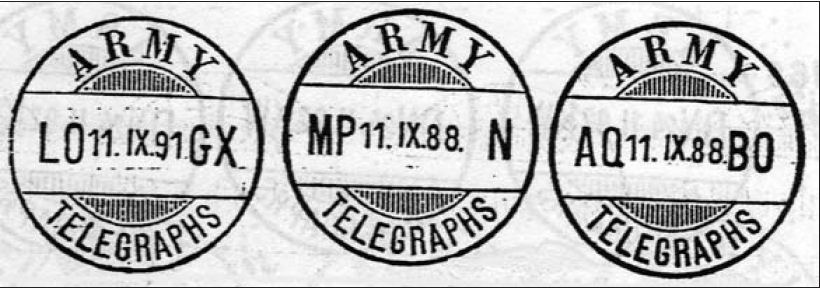
Early impressions from the Güller record book. Courtesy of Andrew Higson FRPSL.
There appears to have been some variability, here are some 1898, 1899, 1917 and 1918 examples:
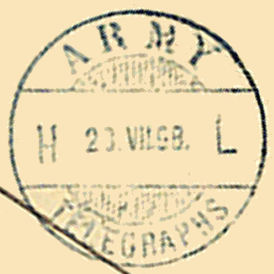
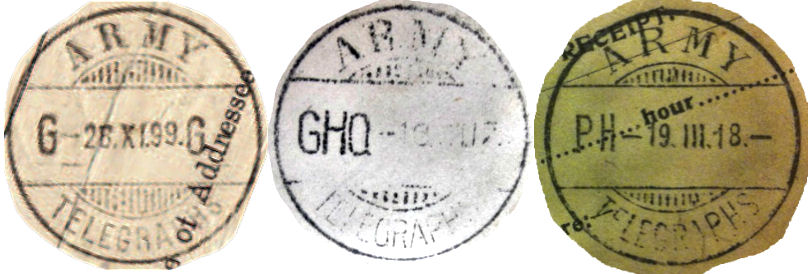
There were 9 steel wheels on these dating stamps.
Because no wheel had the whole alphabet, there were restrictions on the codes that could easily be used.
However it is clear that the engineers could rearrange the order of the wheels to get what they wanted.
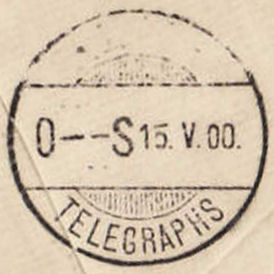
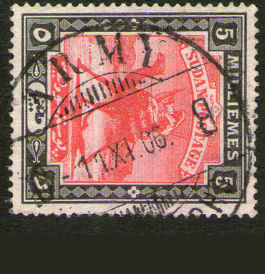
The letters could all be put on one side. It was also possible to put them back upside-down.
Shown here are examples to scale of 1916, 1921 and 1945.
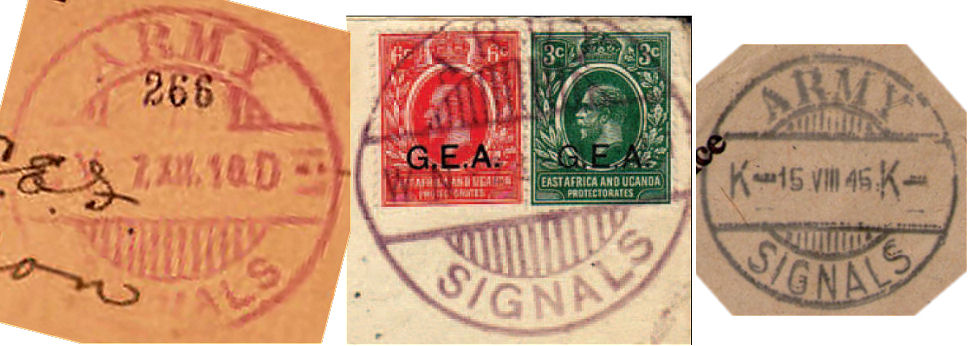
The first were larger and appeared about 1916 in magenta, and at least some had a space for a number. These seem to have become violet or blue.
Later ones are in black and the same size as the Army Telegraph ones.
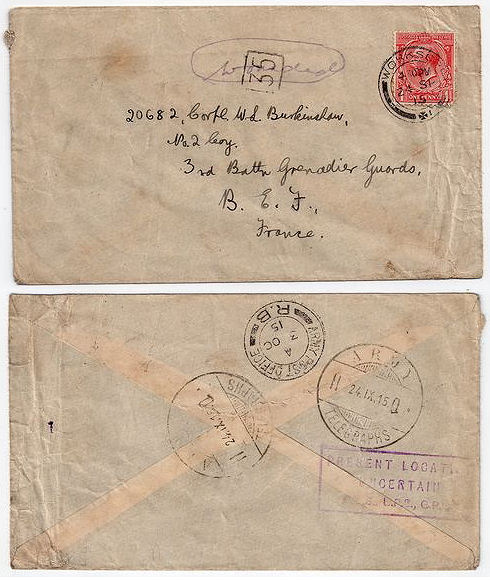 |
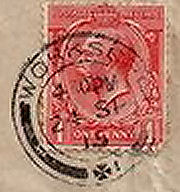 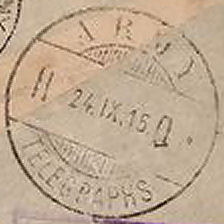 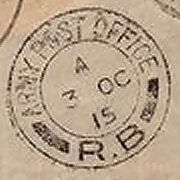
|
| Posted from Worksop 4.30pm on 24/9/15 and stamped the same day with 2 strikes of Army Telegraphs H 24.IX.15 Q- of Headquarters, presumably still in GB. After enquiries it receives an Army Post Office stamp 'R.B' on 3/10/15 Somewhere along the line it has a manuscript 'wounded' and boxed '35' applied to the front. | |
| Images courtesy of Peter Arnett of (bygonesofbridlington) on eBay. | |
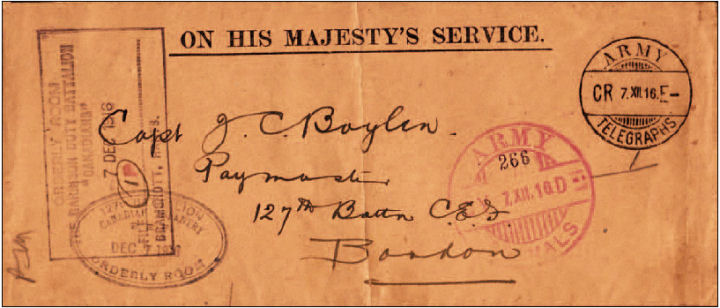
December 1916 cover with Army Telegraphs code 'CR E-' and red Army Signals coded 'CY D-'
It was sent to the 'Canadians' at Bramshott, so 'CR E-' could stand for Canadian Regiment - Erie (Camp).
but perhaps not. (Source: Andrew Higson)
D.R.L.S. (Despatch Rider Letter Service) dated 16/8/1917.

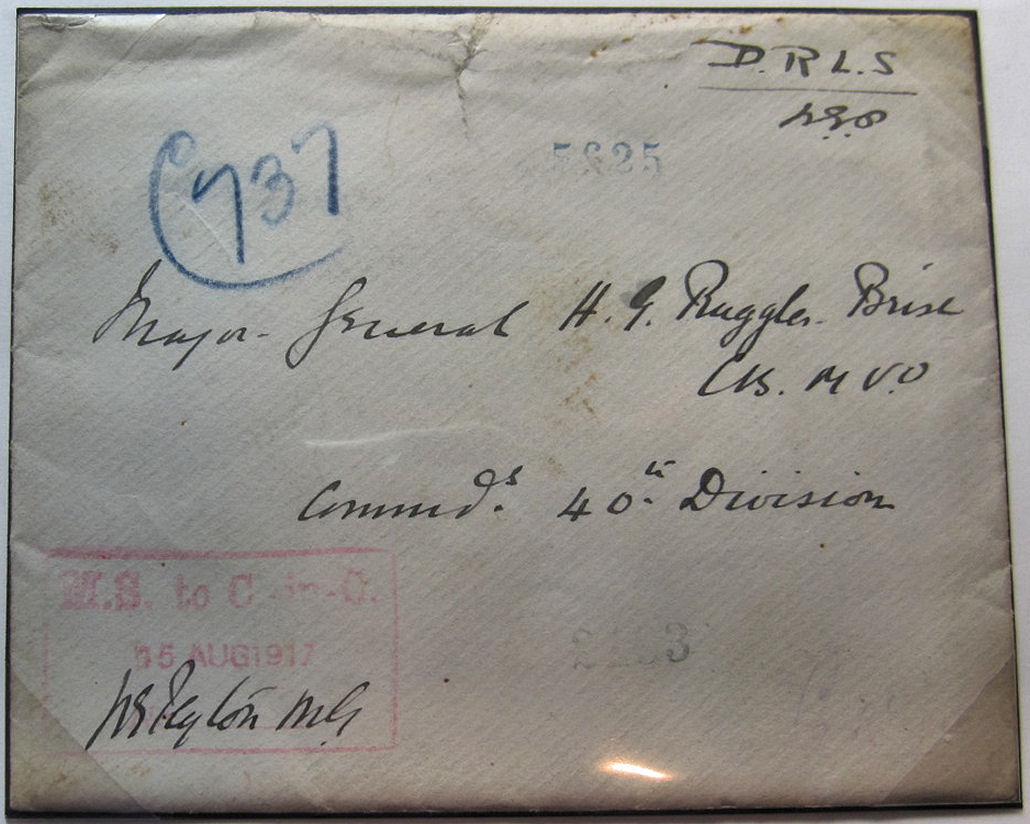
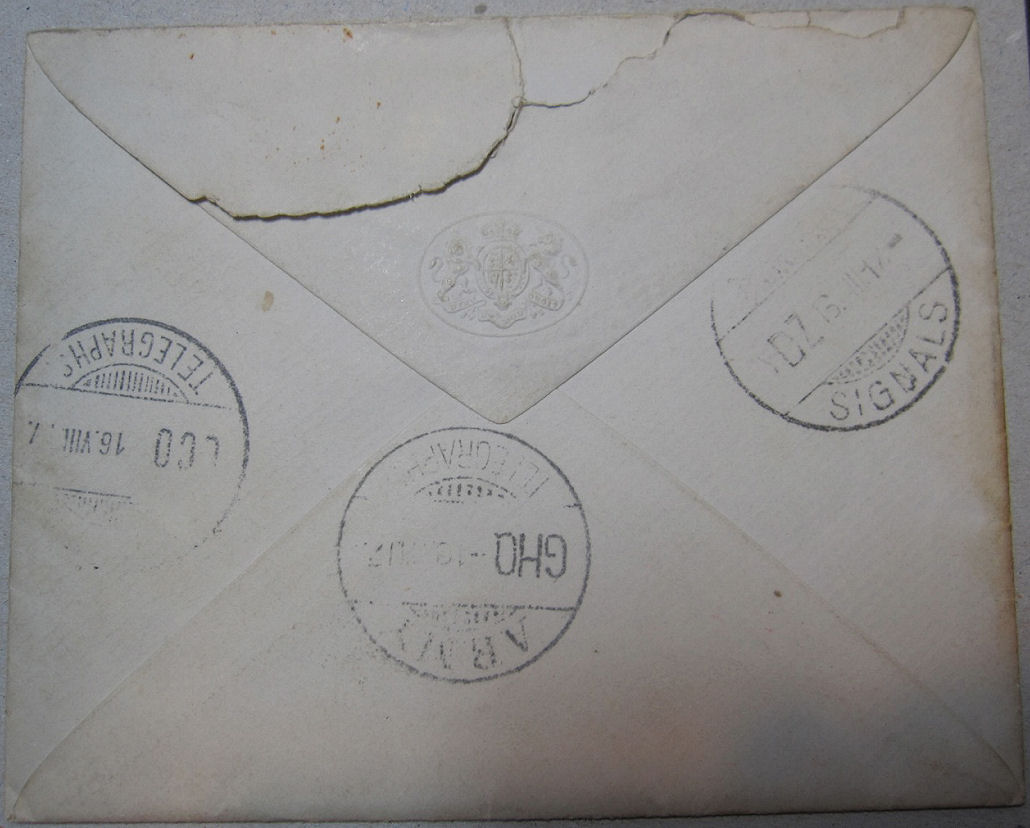
Images courtesy of Mark Gibson.
D.R.L.S. (Despatch Rider Letter Service) dated 2/11/1918.
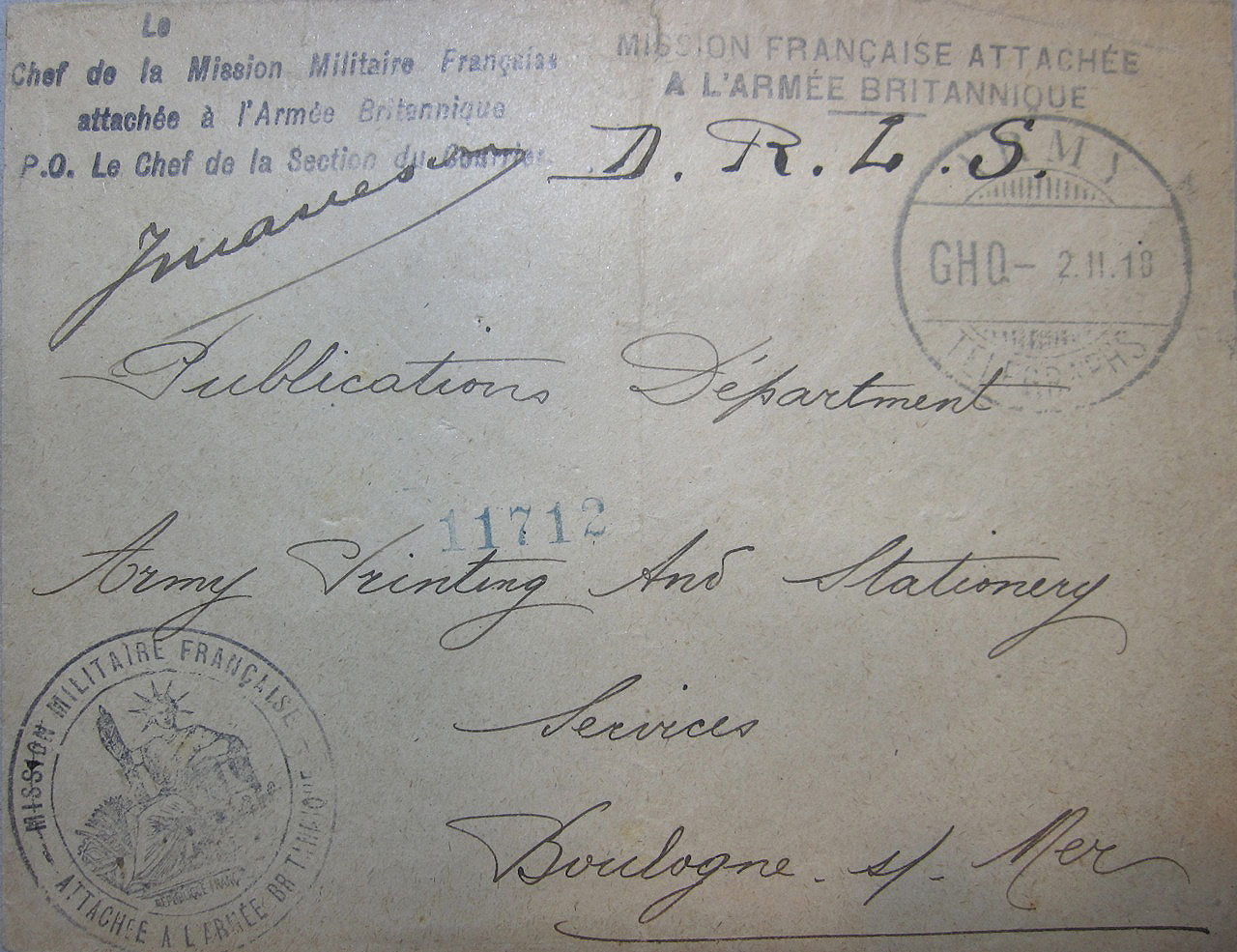
Image courtesy of Mark Gibson.
Front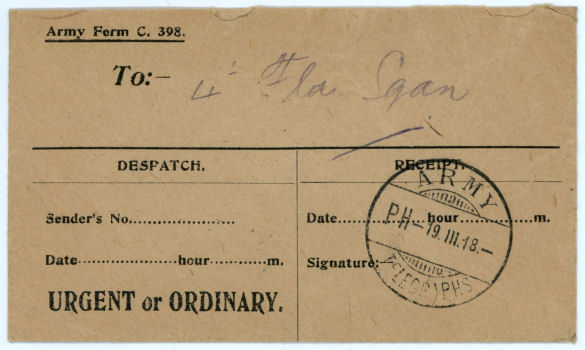
Back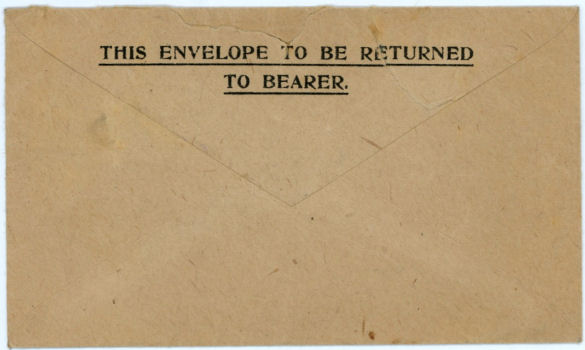
The Gallipoli Peninsula is part of Turkey and protrudes into the Aegean Sea.
In an attempt to gain access to Constantinople (Istanbul), the allied forces planned an attack on Gallipoli.
Bases in Alexandria and the Island of Lemnos (Greek) were used to plan and support the operation.
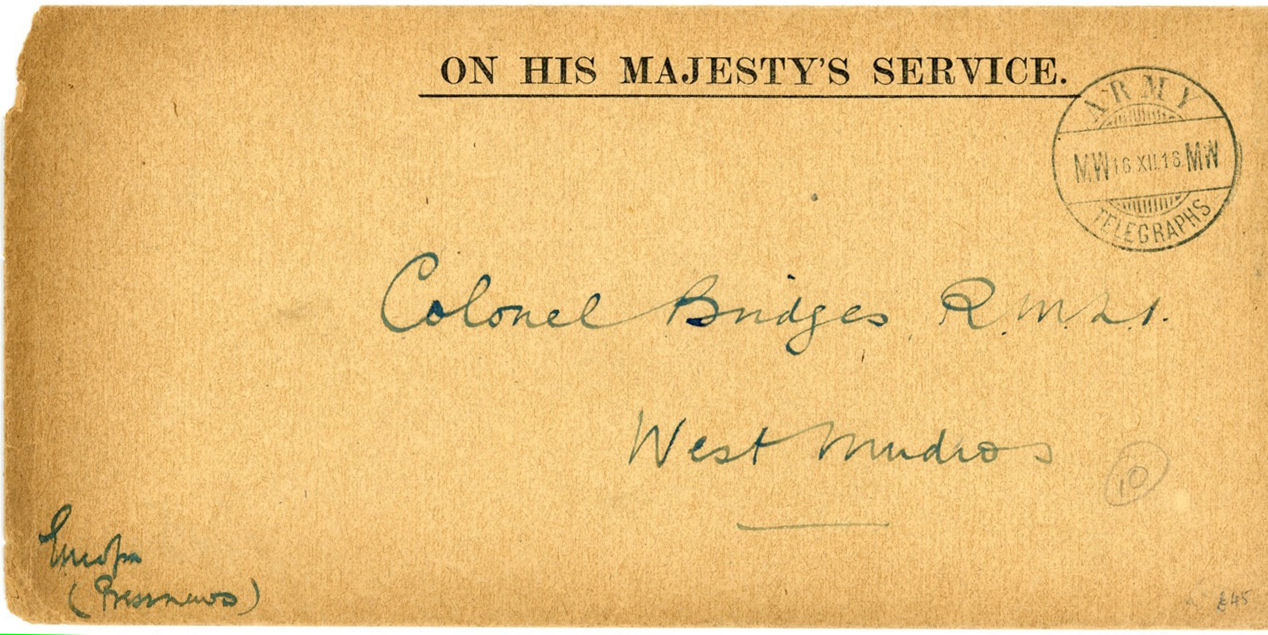
This cover of December 1916 is addressed to Colonel Bridges at West Mudros.
This would seem to be Lieutenant-Colonel Francis Doveton Bridges, RMLI (Royal Marines Light Infantry).
The code MW MW has previously been attributed to Gallipoli, but by this date the allied troops had been withdrawn.
Instead it seems likely that the code is for "Mudros West". - Image courtesy of Mark Gibson.
Coincidentally, another Colonel Bridges was commander of the Australian Imperial Force and
was shot by a sniper in Gallipoli on 15 May 1915, dying 3 days later on a hospital ship bound for Alexandria.
The cover below of May 1917 is simply addressed to 'The Commanding Officer'.
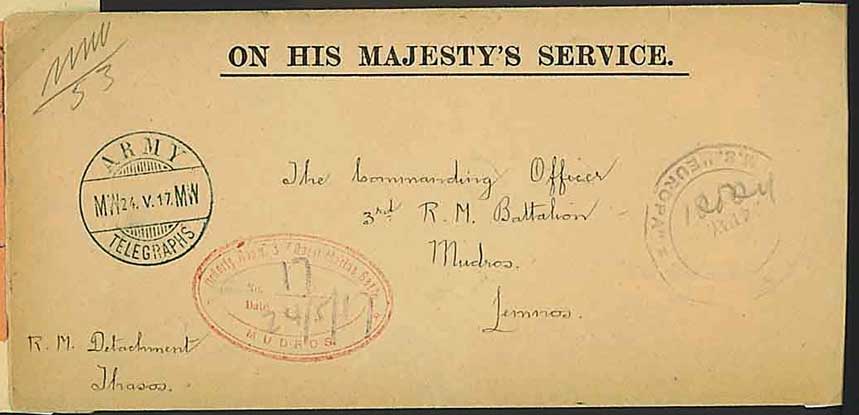
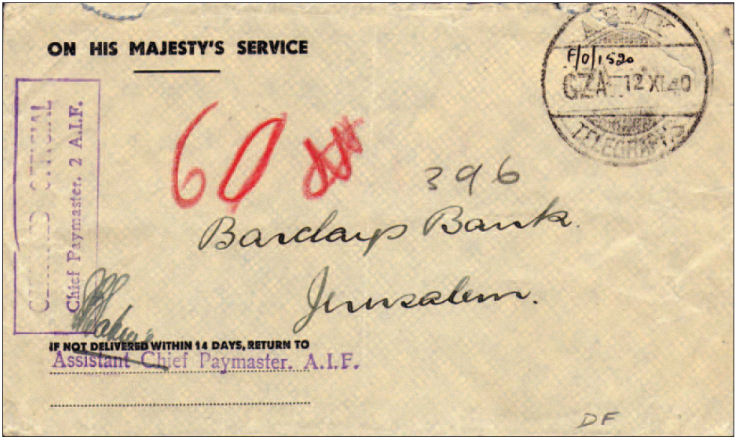
Army Telegraphs coded 'GZA-12.XI.40' (Gaza ?) Palestine.
A.I.F. is probably (Second) 'Australian Imperial Force' (Source: Andrew Higson).
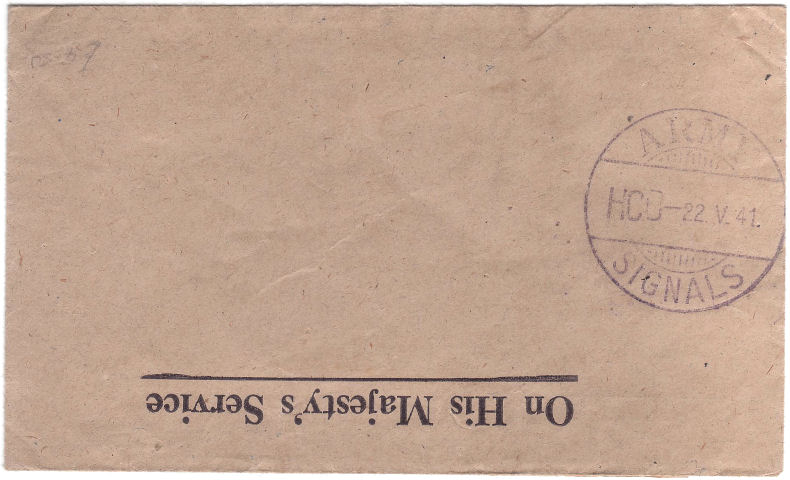
An O.H.M.S. envelope with "ARMY SIGNALS" cancel HCD-22.V.41. Courtesy of Steve Lawrie.
The reverse, shown below shows the previous use covered by an 'economy label'.
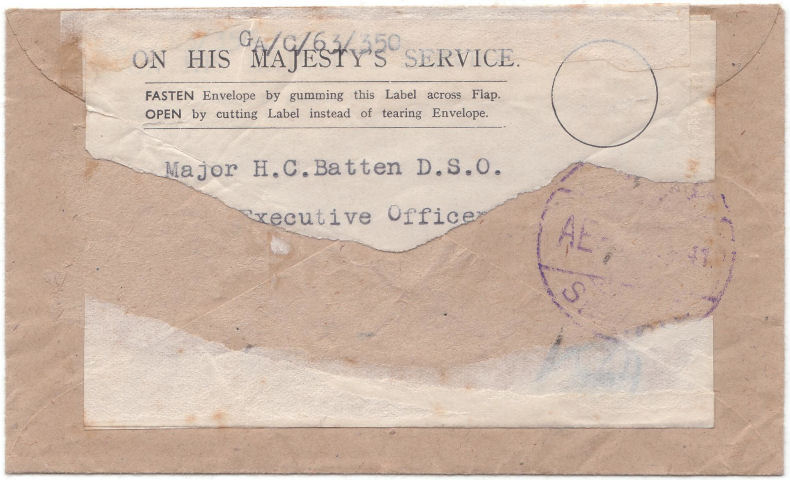
Reverse showing code AE-
These next two O.H.M.S. envelopes are mine at least :)
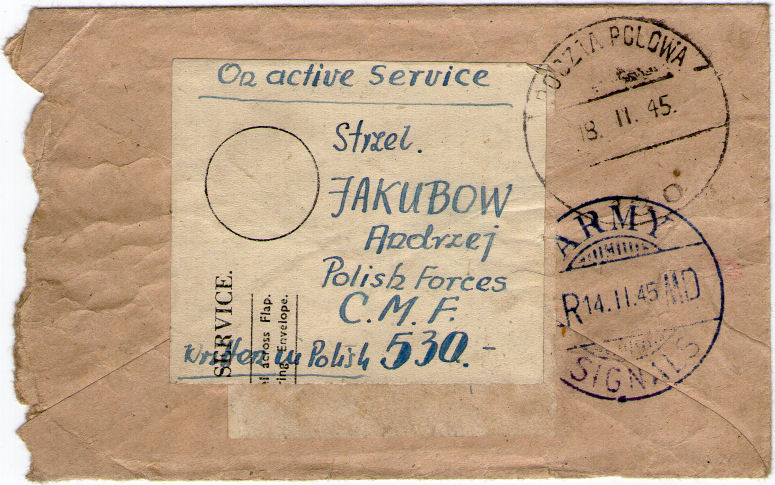
The back of an O.H.M.S. envelope (containing contents typed in Polish) of February 1945 showing "ARMY SIGNALS" cancel
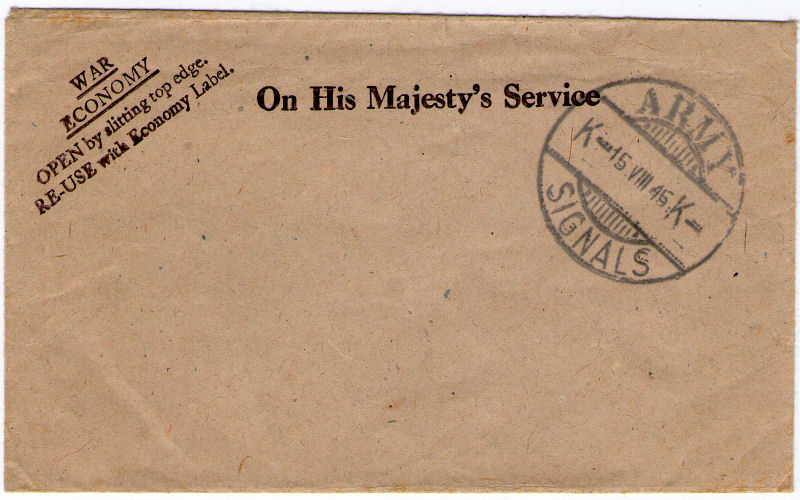
The front of a different but similar O.H.M.S. envelope with the (address?) label torn off the back leaving no clue of location.
TAK-15.X.46. Army Signals Cancel with Cachet of 26 Demob Centre, Takoradi and Takoradi, Gold Coast CDS - courtesy of Grosvenor Auctions.
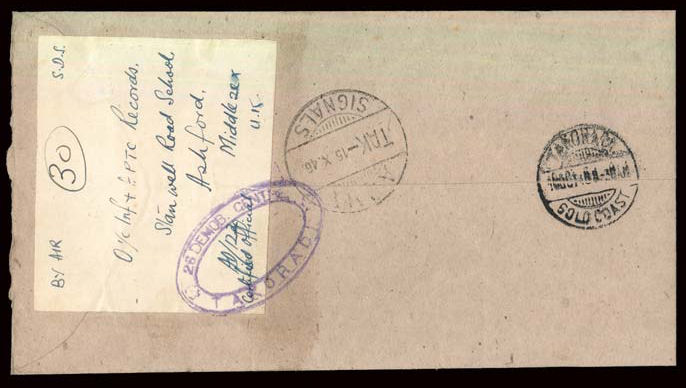
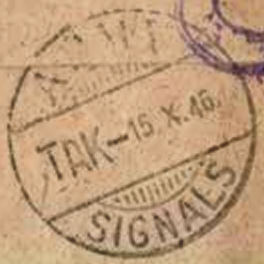
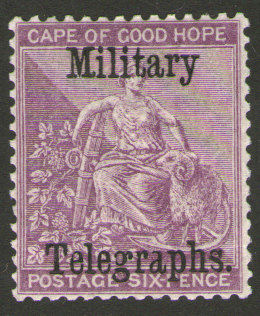 |
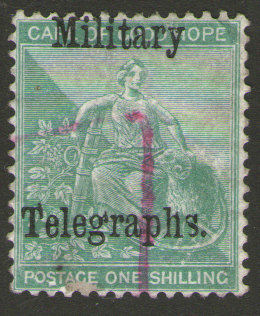 |
| GB-H9 | GB-H10 |
Langmead & Huggins (page 95) mentions the 6d (Wmk: Cabled Anchor) and 1s (Wmk: Crown over CC) of Cape of Good Hope
being used after September 1885 in Bechuanaland by British forces.
| RH # | Hisc. | Description | Rarity | Mint | Used |
|---|---|---|---|---|---|
| RH9 | H9 | RESERVED (see under Bechuanaland) | |||
| RH10 | H10 | RESERVED (see under Bechuanaland) |
For consistency, I have moved these to Army Telegraphs 2 page where I also list other stamps
used by the British Army that were not valid for use in the British Isles.
| Shortcuts to different sections : | |||||
| Army Book, 295 A | Army Book, 295 C | Army Form, C2121 | Army Form, C.2128 | Army Envelope C 377 | Army Envelope C 398 |
A blank 'Army Book 295 A (i).' Sending form used on 6/9/98 on a

Printers imprint of Wyman & Sons Ltd. London. Image Ex. Andrew Higson, courtesy of Spink & Son.
Army Book, 295 C." form for Military Telegraphs, printed by Harrison & Sons, London. This is a receiving form used at Setlagoli, Bechuanaland 14 July 1885.

As illustrated by L & H (Fig171, page 95) - Image courtesy of Mark Gibson.
A later Army Book, 295 C." form, this for Army Telegraphs and printed by Jas. Truscott & Son, London. This is a receiving form used at Pietersburg, Transvaal 20 June 1902.

Image courtesy if Ian Paterson.
Undated Army Telegraphs & Signals Form C2121. (Printed by Eyre & Spottiswoode, London)
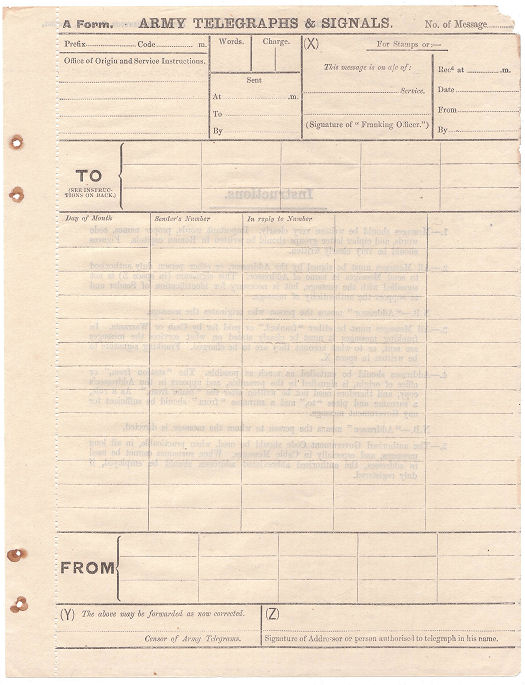
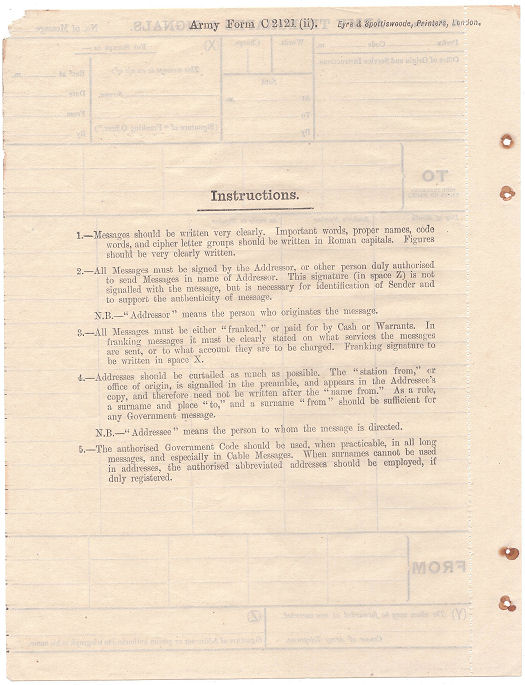
Image courtesy of Steve Lawrie.
Army Signals Form C2128 used 21 March 1941, Ipswitch to Nairobi. (Printed by CEA ?)
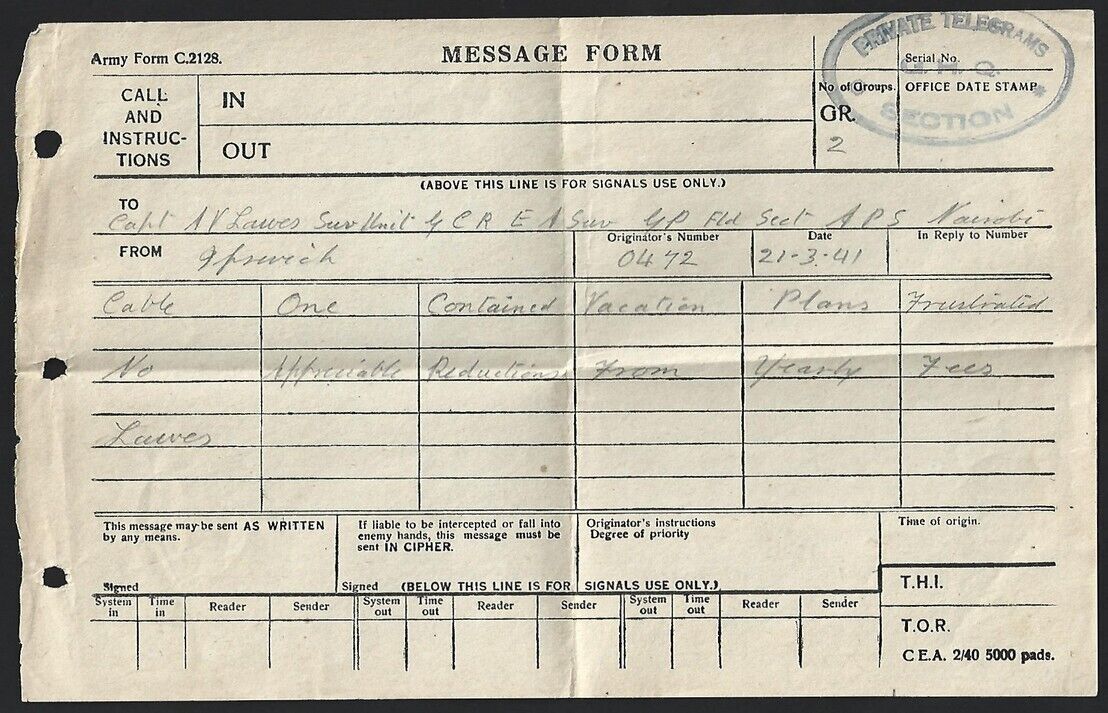
Imprint bottom-right reads "C E A. 2/40 5000 pads." which I take to mean CEA printed 5000 pads of them in February 1940.
Image courtesy of AlphaOmegaPhilately on eBay. (Click on image for listing).
-W 25.VII.02 D- of Wolmaransstad on O.H.M.S. Army Telegraph envelope C377 - courtesy of Grosvenor Auctions.
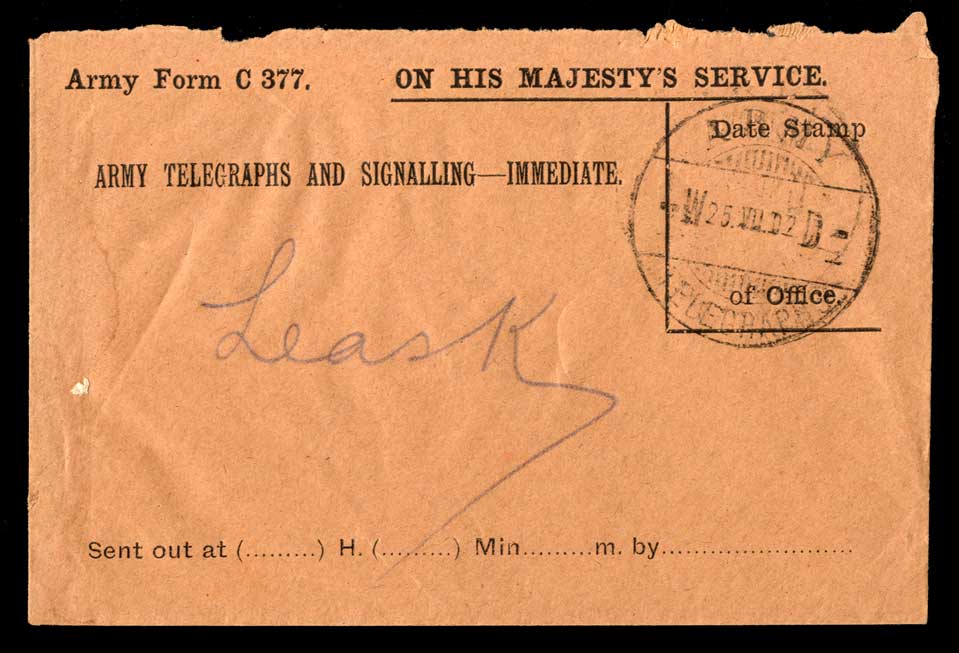
Front and back of Army Form C. 398 used in 1918

A am obliged to the following for helping me with this web-page :
Peter Langmead & Alan Huggins for "The Telegraph Stamps and Stationery of Great Britain 1851-1954" the book that got me started on this.
S.E.R. Hiscocks for the book that filled in many of the gaps: 'TELEGRAPH and TELEPHONE Stamps of the World, a Priced and Annotated Catalogue'.
GB Overprints Society
Many illustrations provided by Dr Andrew Higson FRPSL
Many illustrations provided by Dr. Mark Gibson
Many illustrations provided by Grosvenor Auctions
Last updated 5th. February 2024
©Copyright Steve Panting 2012/13/14/15/16/17/18/19/20/21/22/23/24 except where stated.
Permission is hereby granted to copy material for which the copyright is owned by myself, on condition that any data is not altered and this website is given credit.